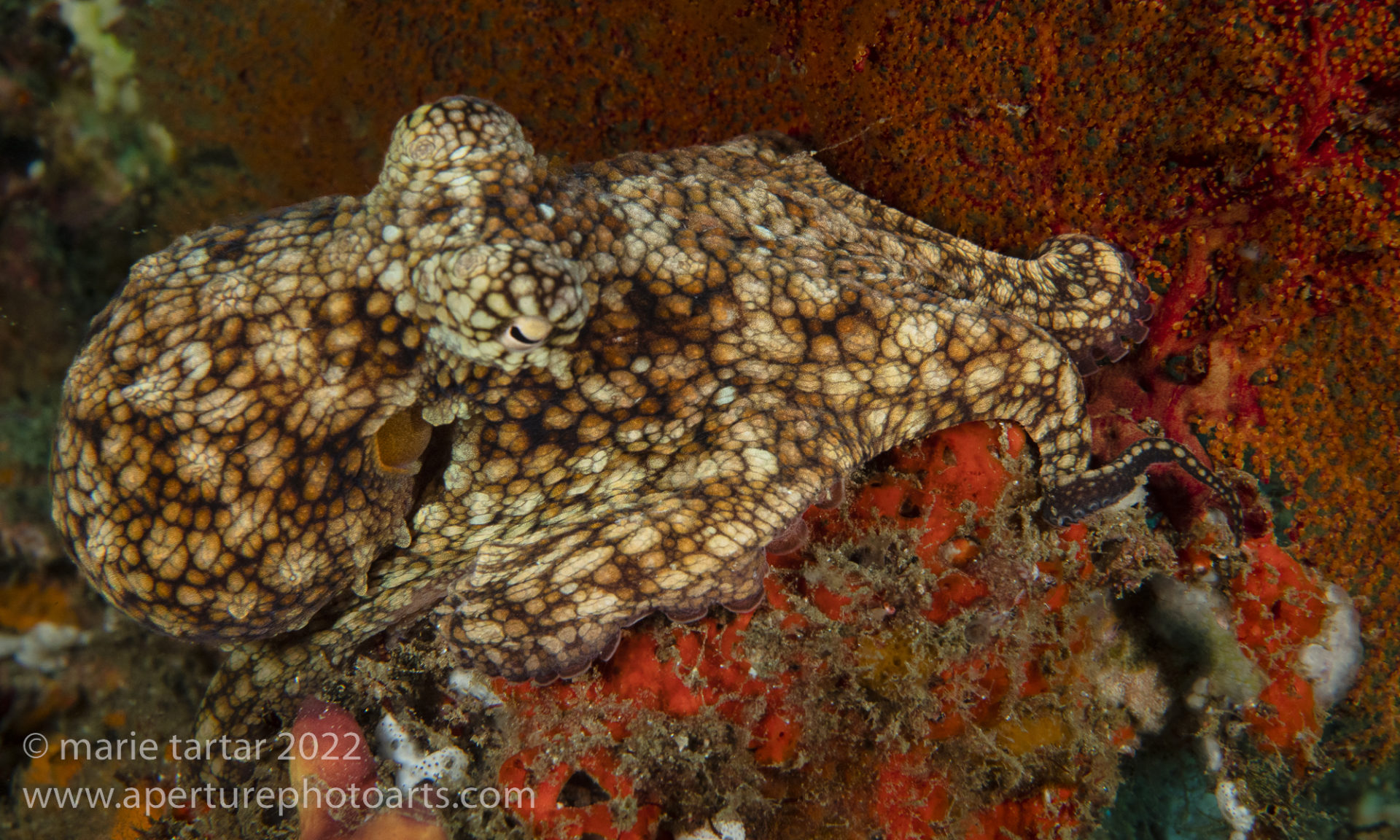
Friday, October 7, 2022
No good adventure begins uneventfully, or so it seems.
2022 was a year dominated by pandemic make-up trips, with Yellowstone winter photography in February, Chile and Patagonia in April and Namibia in June all having been postponed up to 2 years due to the pandemic. At last we would embark on a voyage which would unfold in its original time slot on the calendar, since it was scheduled before the pandemic, all the way back during that innocent fall of 2019.

A reason by itself to return to Baja’s warm waters: the sea lion rookery of Los Islotes. A California sea lion parts the silvery mass of sardines effortlessly.
We had never met the organizer, Lynn Morton of Deep Connections, in person before. Her husband, Mike Boom, is an accomplished videographer. Greg was coming from Chicago, but the rest of the 15 divers were members of Lynn’s diving co-operative, all new to us .
This would be a traverse, from south to north, of the Sea of Cortez. Our last dive trip in southern Baja was in 2017.
Flying into Los Cabos is only 2 hours from San Diego and we were meeting up with the group a day before boarding the boat, staying in San Jose del Cabo at the El Encanto Inn in the arts district. Our midday departure meant we didn’t even have to awake particularly early. What could possibly go wrong?
Rushing around the house, zipping up bags, unplugging appliances, with all the last minute leaving for 3 weeks details to attend, I was brought up short at the threshold to the exercise room bathroom by a squish underfoot. Uh oh, unexplained water is never good. And there was more, a sheet of water on the floor of the bathroom. WTH?
We don’t use that bathroom much, but it is downstream from our upstairs bathroom, where we had showered that morning. I summoned Steve, who became a whirling dervish, manning a special vacuum cleaner used to shampoo carpets. Root encroachment on a drain was suspected as the cause. Our housekeeper, Berta, comes on Fridays, but that day, with the water shut off, there would be no laundry done. Rather, we tasked her with connecting with the roto-router outfit and letting them into the house after our departure.
Lynn had paired us up for transportation to San Jose del Cabo with others in the group with similar arrival times. But first, there was the customs gauntlet to run. The dive photography community was up in arms about being charged, sometimes hundreds of dollars, for bringing into Mexico so-called “professional equipment”, including housings. More than two camera bodies was another potential fee charge. Reportedly, this policy was enacted as retaliation for tariffs enacted during the Stump administration.
As we approached the officer with two fully laden carts, she asked:
” Do you have a house here?”
“No.” (maybe that was the wrong answer?)
A closer look had her zeroing in on Steve’s battered grey plastic Pelican case, stuffed full of gear, including his housing and multiple ports, strobes and accessories.
Through the x-ray machine went our bags and my rolling case with my underwater housing was also singled out for opening and inspection. Out came the calculator and the questions began. How much did this cost? How old was it?
I emphasized the age of our housings (mas de 5 años!) trying to plea bargain down to a reasonable charge. Finally, a sum was arrived at for us to be able to carry our own gear into Mexico and use it: $114 US total. Not good, but it could have been much worse.
Dan and Sarah from Los Osos, near Morro Bay, were already in our transport van when we finally emerged into the sunlight. The driver had supplied them with beer, helping to alleviate the longer than expected wait.
Greg had arrived from Chicago earlier in the afternoon, along with the rest of the group, most of whom knew each other already from prior Lynn co-op trips. They included Joyce and Matt from the Detroit area, their regional neighbor Mark, Mark’s former neighbor Carlton, Yung and Ruth from Minneapolis, Laura from Long Beach, Dave from Cool (northern CA near Sacramento), retired pathologists Brad and Mary, Rolf and John. One of the group, another Sarah, tested positive for Covid (a boat requirement, not a Mexican one) and had to cancel at the last minute.
Lynn had booked a large table for happy hour a couple doors down from the hotel at Baja Brewing. Although not much of a beer drinker normally, I did enjoy their Fresh Razz, with mango and raspberries blended with their Baja Razz raspberry inflected beer. We held off eating, as we had dinner reservations at a farm to table restaurant called Los Tamarindos .
On the phone, the restaurant seemed in walking distance, a 25 minute walk. We started out walking but wavered when we reached what appeared to be a highway, not very pedestrian friendly looking. We summoned an Uber and learned from the driver that one of the two approaches was washed out by rain a few weeks before. We enjoyed a nice quiet meal on an inviting patio, sparkling with lights overlooking the town. Our starter shrimp tacos were served on jicama rounds instead of tortillas. Steve and I shared a pork shank in a green mole sauce and the roasted suckling pig while Greg went the healthier route with cauliflower baked with a traditional mayan salsa.
Saturday October 8, 2022
Even noise from a next door bar couldn’t have kept me awake. After packing up and storing our luggage for the day, Steve and I phoned into a group meeting via Airpods while dawdling over an extended breakfast on the shaded front patio of Ruba’s, across the street from the hotel. Trying to preserve my appetite, I nibbled at a chia pudding with fruit and nursed a latte, my last coffee for a while (the urge to pee underwater is strong enough without adding caffeine in the mix!). Greg joined us later as we continued to listen in on the meeting. I was still sitting there when our friend Cindi LaRaia passed by, on her way to meet us for lunch at the next door taqueria, La Lupita. Cindi is also a dive travel agent and we have enjoyed traveling with her, most recently to French Polynesia and Cuba and are planning a Baja mobula trip with her in June 2024. She recently moved to San Jose del Cabo after living for many years in northern California.
We had a great time catching up over a liberal sampling of tasty tacos. Afterwards, we wandered through the arts district, learning about fire opals and tasting tequila (and stocking up) at Tequila Town.

Great to see another dive buddy in San Jose del Cabo, dive travel specialist Cindi Laraia. We tasted a few tequilas along the way.
The afternoon worn away, it was time for our transfer to the boat, the Rocio del Mar, our floating home for the next 12 nights. Soon, the dive deck was covered in a pile of suitcases from which dive gear was extracted and installed on tanks waiting around the perimeter of the stern. Bob, the head divemaster, gave us boat and safety briefings, after which there was camera building and the first of many delicious meals emanating from the lower level kitchen of chef Joshua (roast pork on this evening) .
Sunday October 9, 2022
Isla Cerralvo
We motored overnight 14 hours. I was slightly queasy before bedtime. I continued on my Jean Hanff Korelitz streak, listening to The Plot, which kept me enthralled. I had recently finished another of her notable works of fiction, which I also loved: The Latecomer.
We were divided into 3 groups, A, B and C, alternating by day which group went first. We have 2 experienced and affable panga drivers, Sergio and Everardo. To board, we descend a short flight of stairs to the swimstep and have to throw a leg over the side of the inflatable. For taller people, this appears easy. For shorter people, especially geared up, not so easy. With my back flinchy, I elected to have my tank with BCD and regulator installed taken down to the panga.
Our first dive (Punta Norte) was a check out dive, good for sorting out how much weight to wear. With new, uncompressed wetsuits, it is always a guessing game. Since the available weights are homemade, what their denominations are is also a bit of a guess.
I guessed wrong, trying 10 pounds divided between BCD weight pouches, which was a no go. Our guide, Marco, put an additional weight into a BCD pocket. Still no go. He put a second weight into the same pocket and I was able to descend. However, 2 additional weights on the same side made it difficult to do any photography, as I was thrown significantly off balance. I could stay above the reef or sand at any desired depth, but to move in close enough to shoot a subject was almost impossible. I simply didn’t have that fine of control with this arrangement. Ascending for the safety stop saw me spinning around and around. I managed a full dive (63 min 48 ft), but it was no fun being so out of kilter. I fixed this on the next dive by moving 2 pound weights into the back pockets of my BCD.
The water temperature was a delightful bath water 85 degrees!

A jewel moray eel (Muraena lentiginosa), one of my favorites, from Isla Cerralvo in Baja’s Sea of Cortez, Mexico.
Other people had their troubles to sort out as well. Steve, Greg and I were paired with Yung and Ruth and Laura as the B group. Ruth sank immediately to the bottom. It turned out her BCD had a large tear at the shoulder.
Lunch was fish with a caper sauce.
I was better trimmed for the afternoon dives to La Reina and Reynita (65 min 66 ft) and (62 min 65 ft). Marco showed Greg and me an initially shy octopus on dive 3.
Afterwards, I started an intriguing boat book, A Visit From the Goon Squad by Jennifer Egan.
Joshua produced a savory meal of roast chicken with mashed potatoes for dinner, with flan for dessert.
Monday October 10, 2022
Isla Espirutu Santo
Breakfast was enlivened by a poetry reading by Mike of GoPro on a Stick, which cracked us up.
For today, I changed my rig to wide angle. Our B group was first today.
Dive 1, Swanee (62 min 36 ft), was a collection of boulders around a buoy. Brilliant red squirrelfish huddled under outcroppings.

Schooling fish are rarely this cooperative, lining up facing the same way, but these squirrelfish came through at Isla Espiritu Santo.
A green eel was free swimming, and we had a brief sea lion visitation.
Back on board the boat, I enjoyed my hot breakfast of red chiliquiles, frijoles y huevos revueltos (scrambled eggs).
Dive 2 (62 min 60 ft) was the Salvatierra, a ferry which collided with Swanee Rock in 1976 (alternate spelling: Suwanee). It had no passengers aboard but a load of trucks and their drivers, as well as combustible fuels. There was no loss of life. The vessel initially settled on its port side. A local dive operator attempted a salvage operation, including driving wooden wedges into the gash, inflating inner tubes inside the passenger compartment, releasing butane from 2 tanks and introducing air into the ballast compartment. Ultimately, the salvage operation was unsuccessful, thanks to Hurricane Liza, which repositioned the ship on its bottom and tore the housing off the deck. Some trucks were salvaged, their owners being motivated by having already paid import fees and needing to produce the ruined trucks to secure replacements, without paying additional duty.
Lots of the structure remains intact. Shy small octopi were seen and Yung found a seahorse at the end of the dive.
After cheeseburgers for lunch, we did a 3rd dive (64 min 68 ft) to another wreck, the Fang Ming, a Chinese vessel intentionally sunk in 1999 as a dive site. The Fang Ming also has an interesting back story. It was seized by the Mexican government in 1995 for attempting to illegally smuggle human cargo (88 men and 7 women) into California.
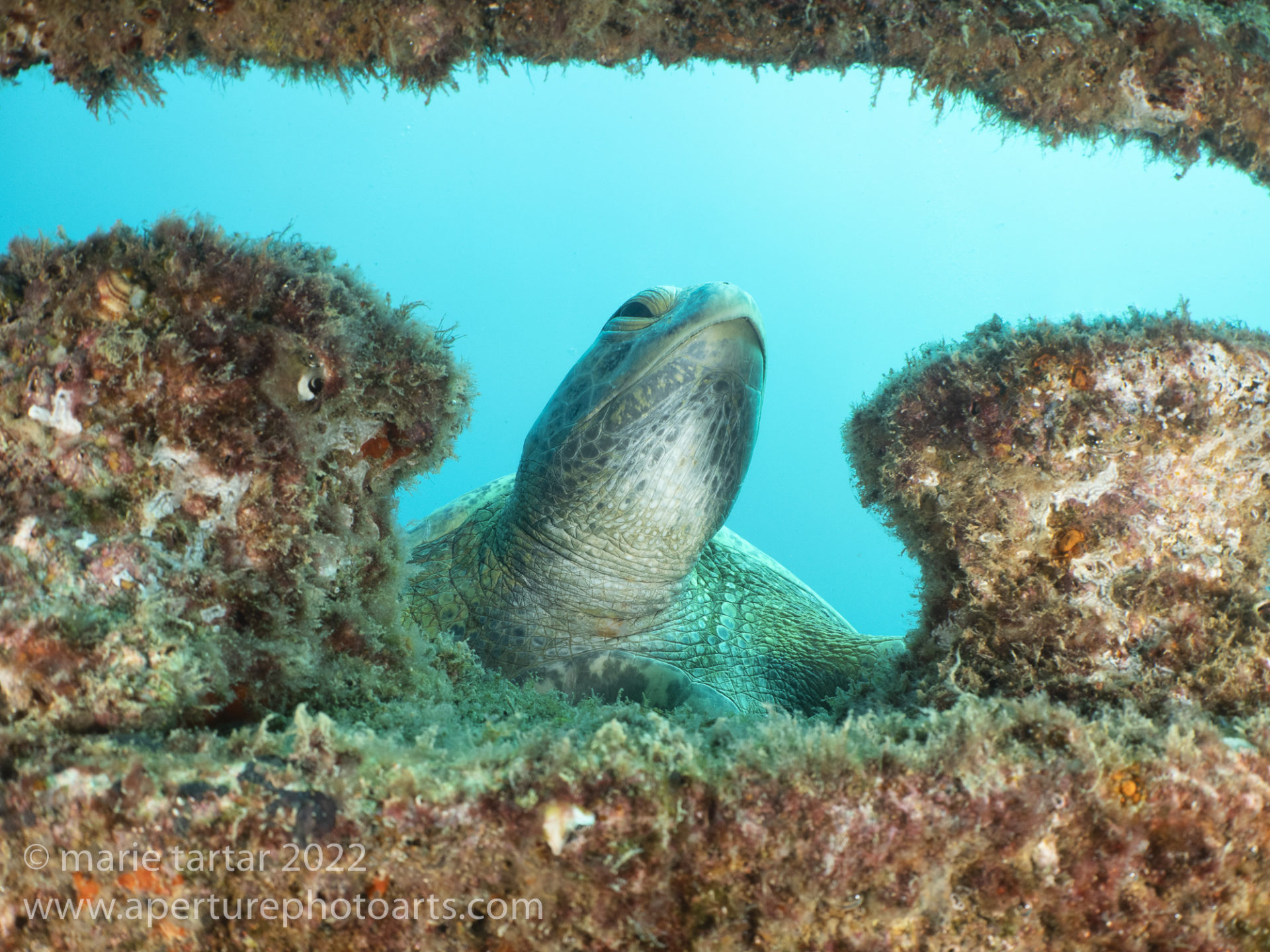
A turtle peers through an opening in the deck structure of the wreck of the Fang Ming in Baja’s Sea of Cortez, Mexico. I had to wait for a stream of diver’s bubbles coming through the window to clear before capturing this turtle’s portrait.
The dive briefing drawing indicated turtles at either end of deck. I thought this was a joke; usually briefings are more along the lines of “we sometimes see turtles on this site”. But there were indeed turtles right where indicated on the drawings!

One of five turtles we saw on the wreck of the Fang Ming in Baja Sur peers through an encrusted deck opening.
Steve lost the group on the descent and didn’t find the wreck. Marco had us stay at the buoy line near one end of the wreck while he looked for Steve, who not finding the group, had surfaced and aborted the dive.
After a dinner of Caesar salad, with shrimp with cous-cous and vegetables, we played a waiting game. Strong lights were put out, hoping to attract plankton and feeding mobulas, but only a handful of mobulas showed, not in sufficient numbers to warrant suiting up. The near full moon may have competed for their attention.
Tuesday October 11, 2022
Los Islotes
Our 8 am entry (63 min 17 ft) in advance of the La Paz dayboat arrivals, ensured we had this protected sea lion rookery to ourselves. Los Islotes was and is one of my favorite dive sites in the world. When it is on, it is magic.
The briefing the night before, including the possibility of being bitten by a sea lion, kept Sarah and Ruth out of the water for the first dive. We can hear barking from the boat.
Sea lions appeared as soon as we plunged in. Conditions were perfect, sunny, with clear water, with silvery clouds of anchovy waving in the shallows, hypnotic to watch. Here’s a snippet of video.
The sea lion pups are inquisitive and explore with their mouths, good reason to be fully covered with neoprene. I felt periodic strong tugging on fins, as did most of us. Laura had her calf nibbled but she was wearing a wetsuit and the skin wasn’t broken.
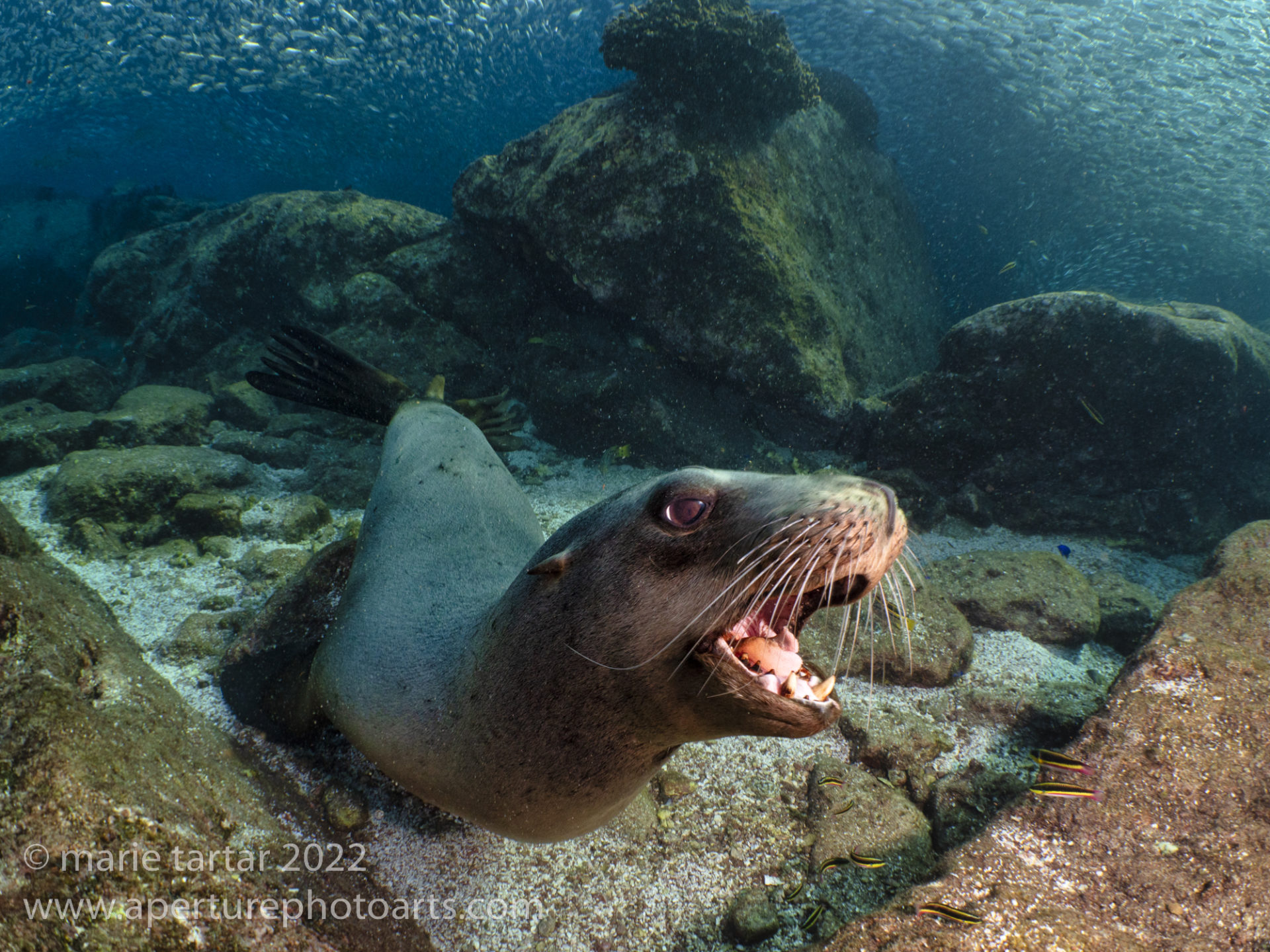
Yes, sea lions at Los Islotes have some wicked teeth and can be mouthy, probing and testing, tugging on snorkles and fins and occasionally limbs.
Regular appearances were made by a big male bull who patrolled us periodically but was mellow about it.

The combination of clear, shallow blue water, the swirling curtain of sardines and the antics of the sea lions at Los Islotes in fall is magic! Big bulls like this can be intimidating, but this fellow was mellow.
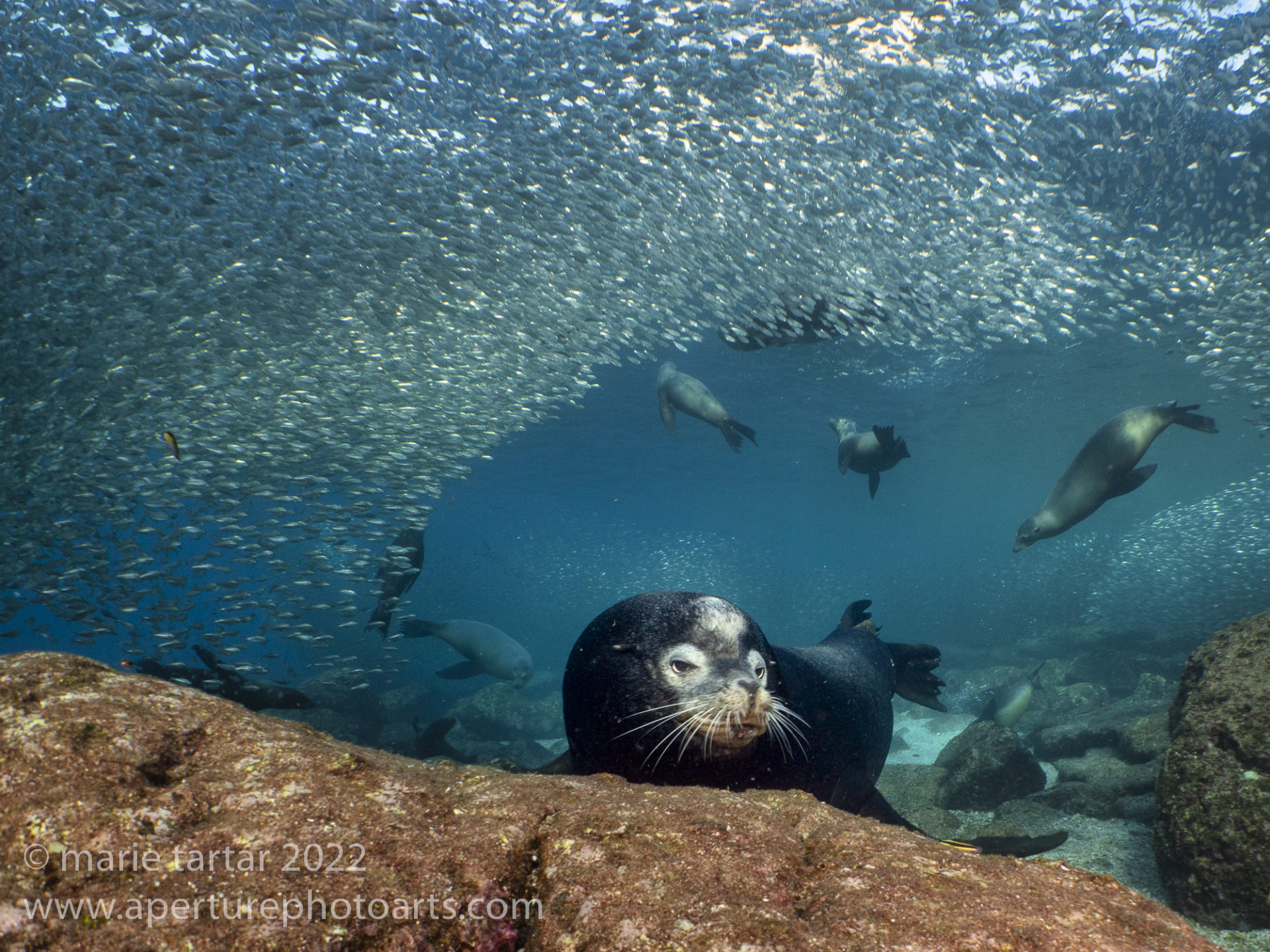
An unusually mellow sea lion bull at Los Islotes, the first dive site I fell in love with and still a favorite after all these years.
Dive 2 (60 min 22 ft) was much the same, with surgeonfish determinedly cropping algea from the boulders. Sarah, who doesn’t care for being away from unlimited air, snorkeled this second dive.
Dive 3 (60 min 26 ft) began on the opposite side of the arch. As we swam through, playful sea lions zipped around us. The silverside parade was more compressed against the island by a quartet of beefy silvery patrolling bonitas.
In the evening, dinner was al fresco, on the top deck, a carne asada fiesta. A cake for Mike and Lynn’s recent 33rd wedding anniversary was dessert. The near perfect evening, with the moon rising over a ridge and a long shimmering reflection in the water, was only marred by the sudden collapse of a chaise lounge onto Mike’s foot. Fortunately, it didn’t seem to hobble his ability to dive on subsequent days.
Wednesday October 12, 2022
Los Islotes
A second day at Los Islotes wasn’t the plan on our original itinerary, but staying a second day here was certainly a popular decision. We had been disappointed to hear we wouldn’t be diving Cabo Pulmo (per Bob, access is difficult for live-aboards), so this was an especially welcome suggestion on Lynn’s part.
Dive 1 (63 min 26 ft) started near arch. We swam in and frolicked with sea lions for a while before moving to a shallow pool covered with anchovies. The visibility was good. At the sea lion pool, there was plenty of action, fun to watch, but mostly too far away for satisfying photography.
On our second dive (59 min 20 ft), a female sea lion nuzzled up to Lynn while she was concentrating on blennies.
After a lunch of minestrone soup and chicken fajitas with beans and guacamole, we did two afternoon dives. Ruth joined us on the third ((61 min 36 ft), having completed a successful check out dive between our two morning dives. We had quick current-driven ride around to the backside, with an acrobatic sea lion finale. Greg managed to capture an image of a diving pelican. We had periodically heard a boom in the water, as they dive bombed the scad, leaving a trail of white foam.
Lights were put out at night to see if feeding mobulas would be drawn in. Just when it seemed we had another scrub, the bell rang out for the first group to suit up. This fourth dive (44 min 19 ft) was shallow and a completely surreal experience. We motored a short run away and backward rolled into a shallow sandy bottom. No flash or flash triggers were allowed. A cone of green light poured down from the surface. It was hard to focus, so I ended up focusing on an adjacent diver. As soon as I landed on the sand, I saw a stingray skitter across the sand, making me nervous to move much or even shift my leg position.
We arranged ourselves in a semi-circle, kneeling on the sand. We didn’t have long to wait before a platoon of mobulas roared across the sand before taking flight into the water column. This happened over and over, a hypnotizing rush. The water was filled with rustled up suspended sand.
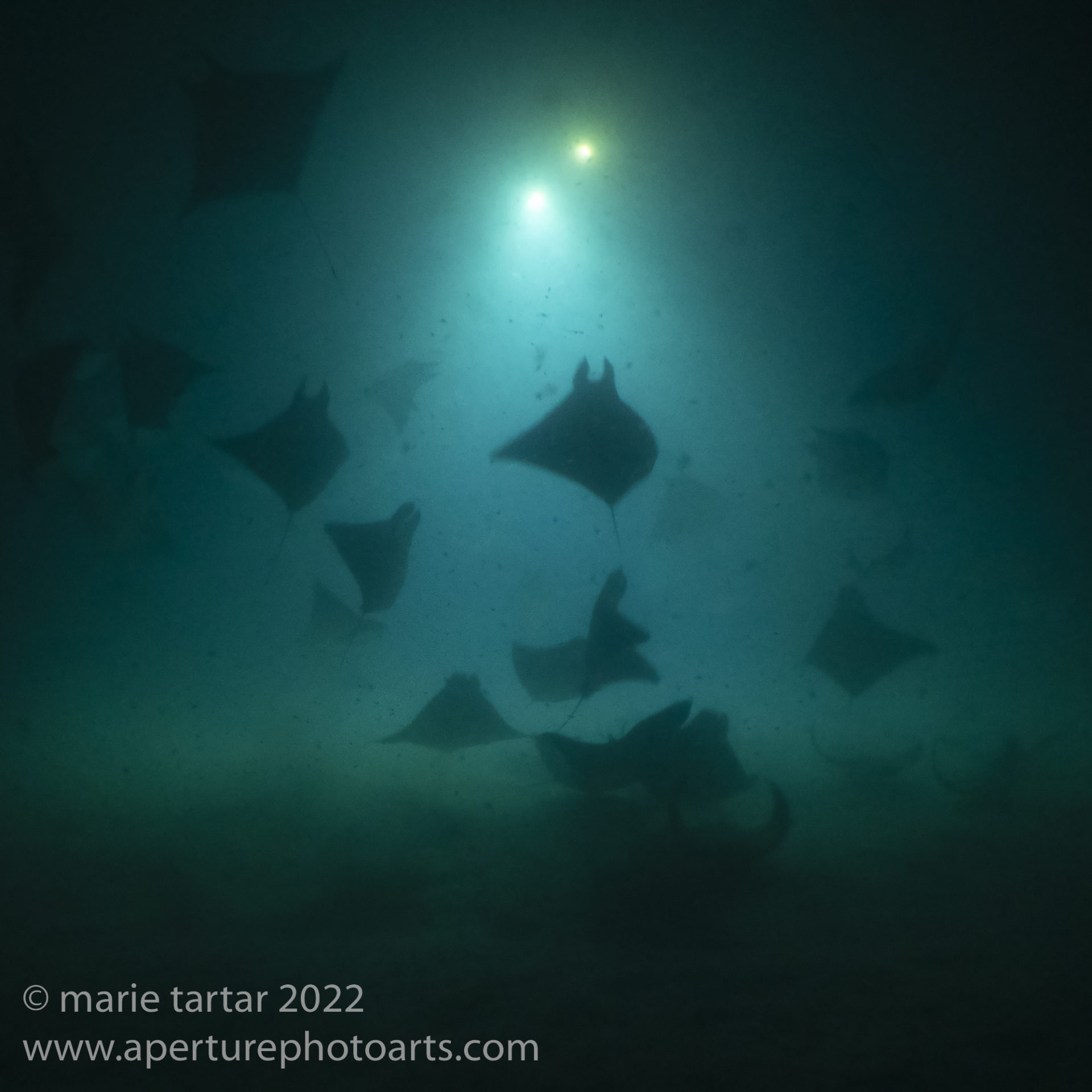
One of the eeriest night dives I’ve ever done, near Los Islotes, Sea of Cortez, Baja, Mexico: night feeding mobulas, attracted to strong lights put out by the Rocio del Mar’s crew, rustle through the sand and swoop up toward the lights, feeding.
In the dark I had trouble locating the button to take video until the last few minutes of the 40 minute dive. A free-swimming eel wriggled into the arena with an occasional puffer fish in the mix.
Yung elected to snorkel and after we boarded the skiff, looking down into the water still lit by the lighted platform, it did look like that might have been even a better photographic option. Laura was inadvertently left behind. She’d been waiting in her room, expecting a bell summons.
Thursday October 13, 2022
Las Animas
From the boat, Las Animas presented a profile similar to the backside of Los Islotes.
Our hot breakfast today was green chiliquiles and eggs to order.
Out first dive was to the north rocks (Rocas-Norte) (59 min 97 ft). The B group was smaller today, just Yung, Greg, Steve and me. Laura appeared on the dive deck wearing a mask due to a sore throat. She tested negative for Covid and rejoined us later.
This was a deeper dive, near 100’. We were hoping for hammerheads, but only saw a large diamond ray in the sand, which swam off on Steve’s approach. Greg found an eel underneath him as we were hunkered down peering into the blue. I saw a segment of a zebra moray, its head and tail buried deep in a rock formation. We had several sea lion swim-bys, including in the background as I was shooting a starfish landscape. A sea lion also zipped by on our safety stop.
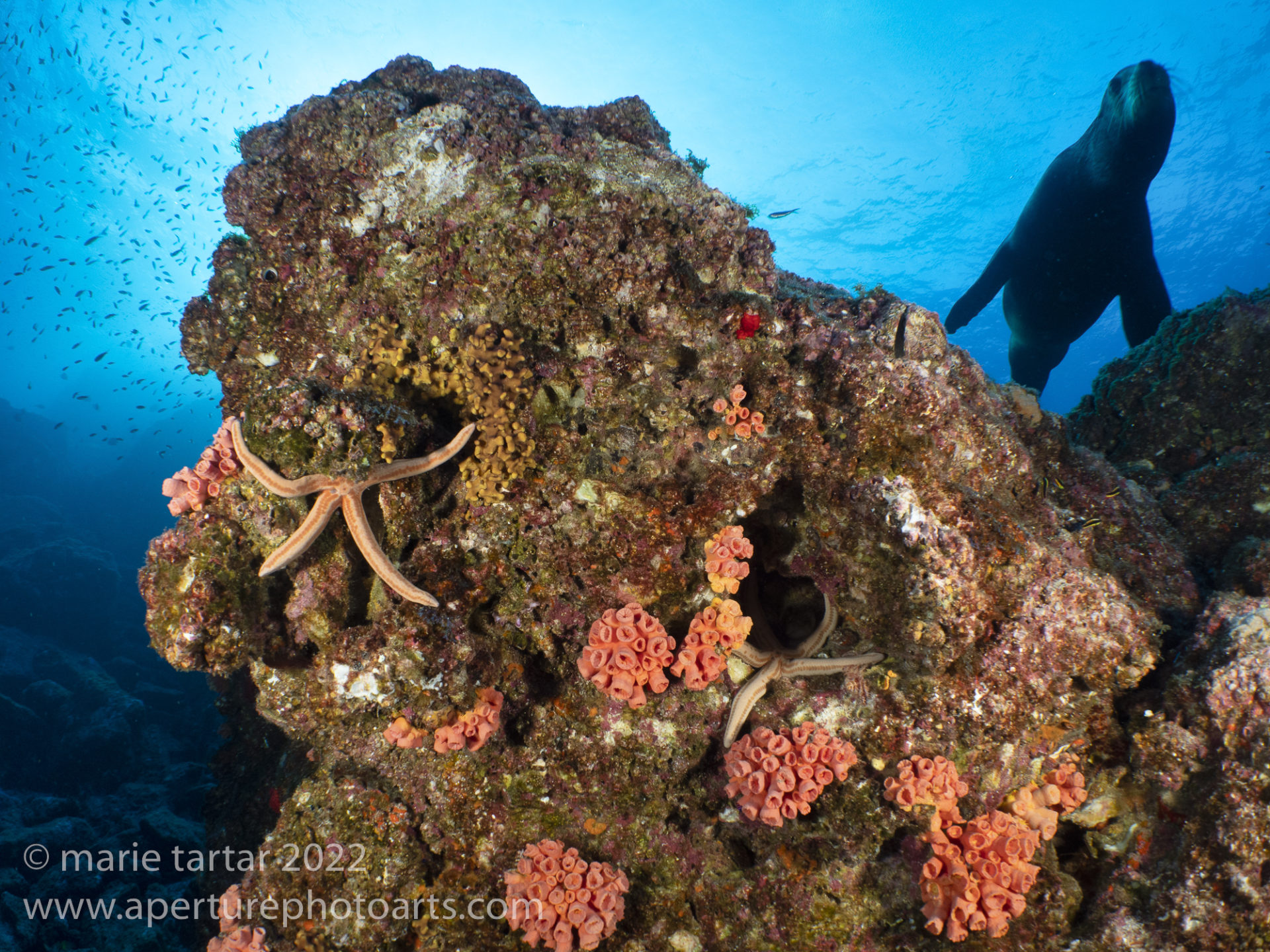
If only photobombers were always so perfectly positioned! I was framing a landscape of this formation when this sea lion zipped by at Las Animas.
Mark was on deck on our return. Displaying amazing calm and presence of mind, he made an emergency ascent from 70 feet after his yoke tank o-ring blew a few minutes into his dive. I was happy to learn our DIN threaded valves are unlikely to blow in this fashion.
On our second dive to Rocas-Este (East Rocks) (60 min 70 ft), a sea lion circled us on our descent, then paused under an overhang with Greg and me.
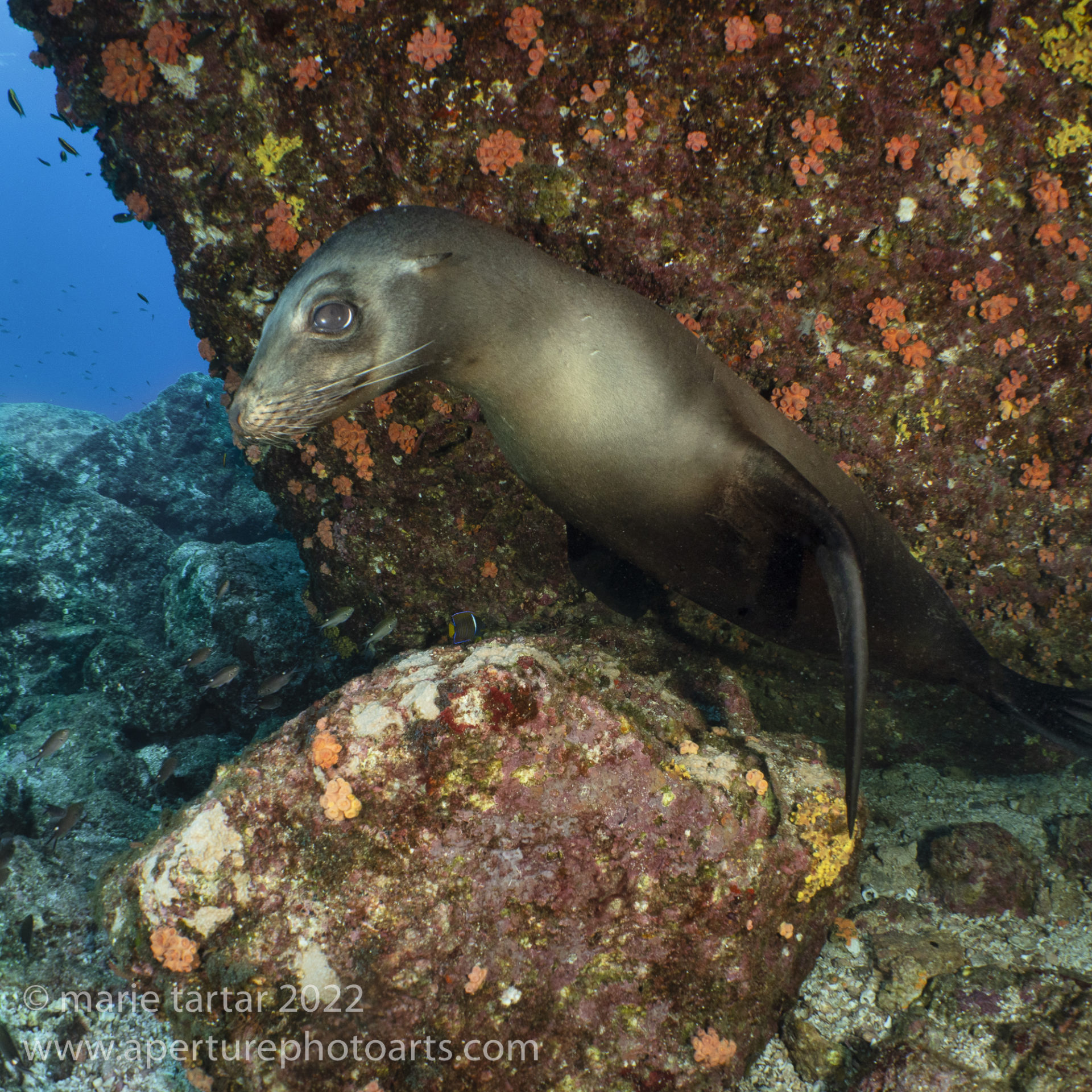
A cooperative sea lion, pausing in front of Greg and me for longer than a millisecond at Las Animas, Gulf of California, Mexico
Later, a quartet of sea lions made a brief appearance. Marco pointed out a small octopus, well tucked into a nook on the reef. There were multiple pretty nudibranchs, but in bad positions per macro shooting Steve. A sea lion saw us off on our safety stop.
After a lunch of cream of carrot soup, followed by fried fish with salad and zucchini, a large pod of dolphins was sighted, prompting a group of us to jump into a panga. I had just enough time to throw a sunshirt over my bathing suit, clamp on a hat and sunglasses and grab my land camera, with a 100–400 mm lens and a 2X teleconverter. The only problem, we quickly found ourselves in the midst of the dolphins, who (for a change) were much too close, at least for this rig! Matt was the only one prepared to jump in with a snorkel and the boat revved around in circles driving the dolphins toward him.
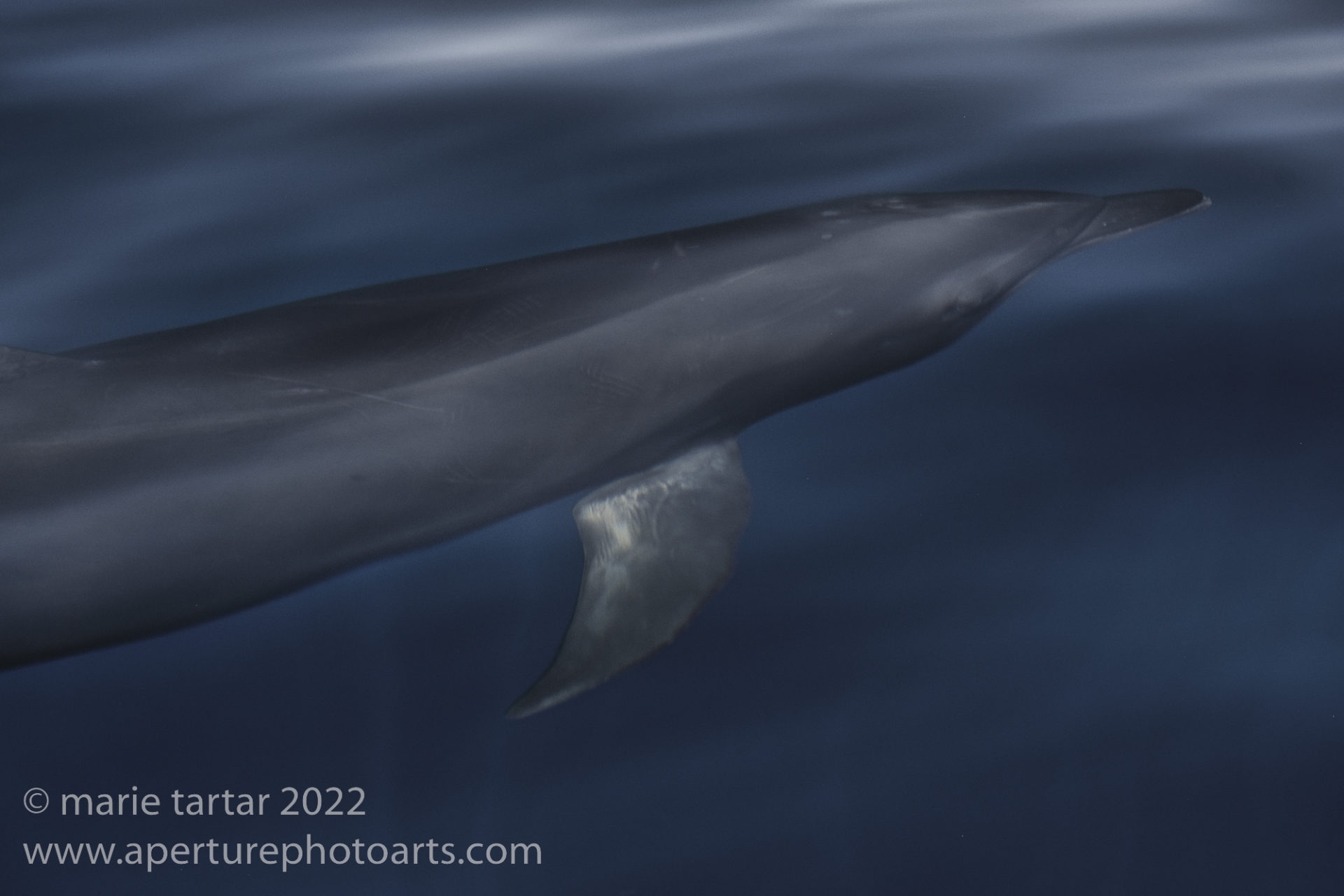
Trying not to fall into the water while toting a long and heavy lens (100-400 mm), bouncing around on the rim of a panga, this is what I could manage as the dolphins raced around us in Las Animas, Baja, Mexico.
Our third dive at Las Animas to the west side (64 min 63 ft) took us inside a large, dark, eerie cavern. A couple of sea lions zipped in and out and reappeared periodically during and at the end of the dive.
After the 3rd dive, as I was slowly disassembling my camera to change to a macro set-up, another call went out: Dolphins! We were again surrounded by a large pod of dolphins, riding the bow, and occasionally leaping alongside the boat. Dolphin photography from the mothership was definitely more productive.
Lasagna, garlic bread and salad featured in the evening meal.
Friday October 14, 2022
Isla Danzante
Our first dive (64 min 58 ft) was to Submarino. It consisted of sand flats and boulders. Bluespotted jawfishes peered out from their rock and shell lined burrows, but quickly retreated from sight on approach. We had more success with a finespotted jawfish (Bocón punteado) (Opistoganthus punctatis), which Marco lured out of its burrow with pieces of shrimp.
I couldn’t understand why Steve was hanging back with such a good subject available but the reason was disclosed back on the panga by a sheepish Steve- he left the lens cap on his camera inside the housing, a mistake every underwater photographer has made at least once. Steve pointed out a tiny Gulf signal blenny. Only with the CMC could I make out this tiny nuptial male (Emblemaria hypacanthus).
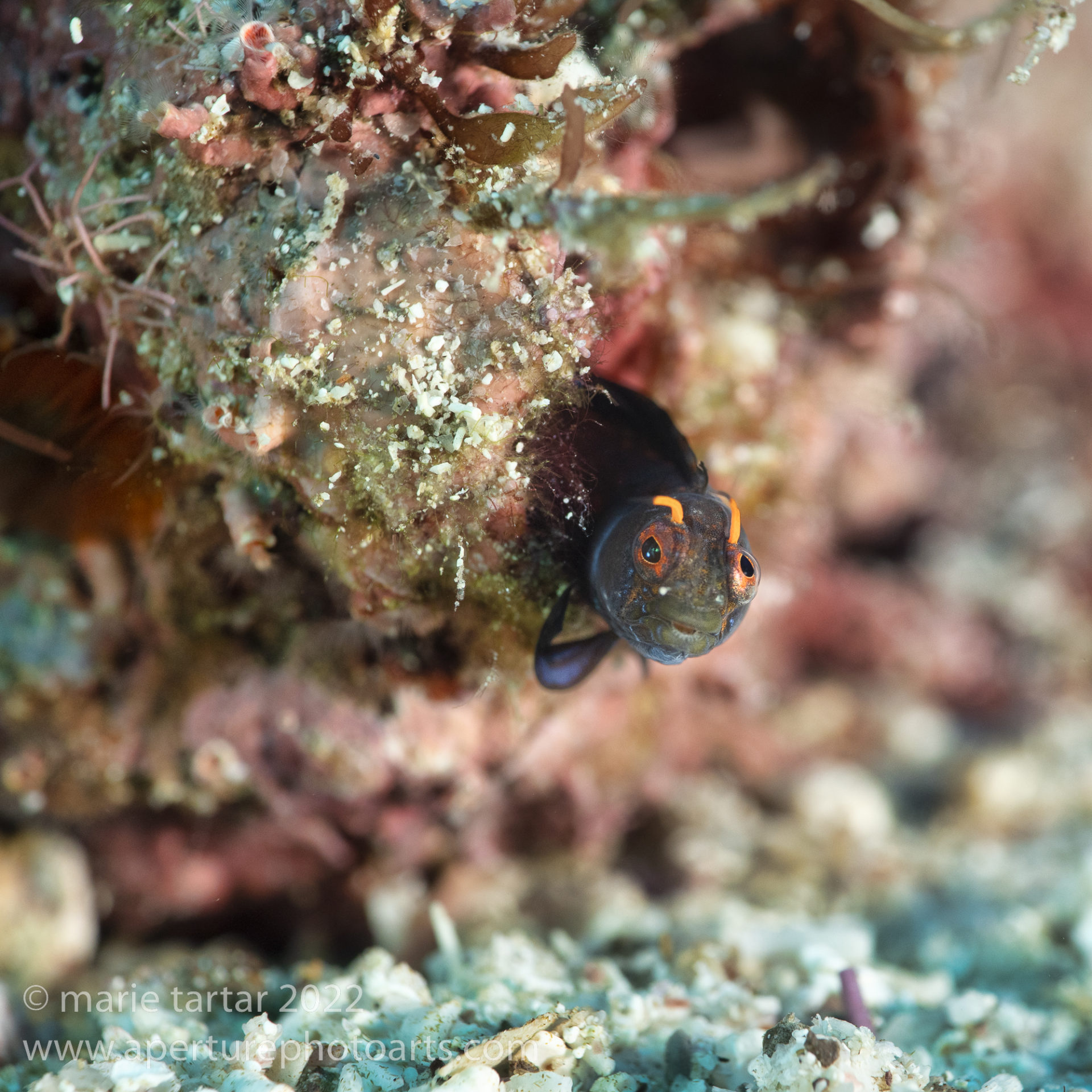
Tiny Gulf signal blenny nuptial male (Emblemaria hypacanthus). I could barely make it out with my eyes; the CMC captures some its intricacy.
While we were occupied with the finespotted jawfish, Marco shook his rattler and pointed out a turtle. Even at a distance, I was not tempted to swim after this sad-looking specimen, which has to be a first. It was not photogenic, missing a front flipper and its shell covered with algae.
Our second dive (63 min 66 ft) was to Silhouette. Ruth expanded our ranks to 5 accompanying Marco down under. A yellow juvenile blue-spotted jawfish frustrated me.
Marco turned over a large shell with pastel decorations. I was puzzled, as it looked empty. Then fuzzy legs appeared, followed by crab eyes- a conch crab!
Two small blennies through the CMC finished off my dive.
Our third, afternoon dive (66 min 47 ft) and our night dive (52 min 48 ft) were at a site called Honeymoon.
The night dive was no honeymoon. We were literally pelted by sizable sardines, constant small bodily blows.
In the late afternoon, between our two honeymoon sojourns, most went ashore to a small crescent beach, from which we climbed up for a nice view.
Saturday October 15, 2022
Isla Coronado/Loreto
I continued to shoot macro in the morning. We dove three times, before being taken ashore to Loreto, a chance for us to walk around and have dinner, while the crew restocked the boat with fresh produce and other provisions.
I realized underwater on our first dive to Gorilla that I forgot my wrist computer, which is usually strapped around one of the strobe arm segments on my camera. I had taken it off to charge. I had been using it as a depth gauge and timer only, wearing a separate pressure gauge, since my Tank Pod was again not working. I stayed closer than usual to Marco to judge the approximate depth. An eagle ray passed through briefly.
Loading up for second dive (68 min 53 ft), to Piedro Blanco (White Rock), Marco slipped with his tank on descending the stairs to the swim step, clanking down hard. He bounced up immediately, uninjured. A large ray made a brief appearance.
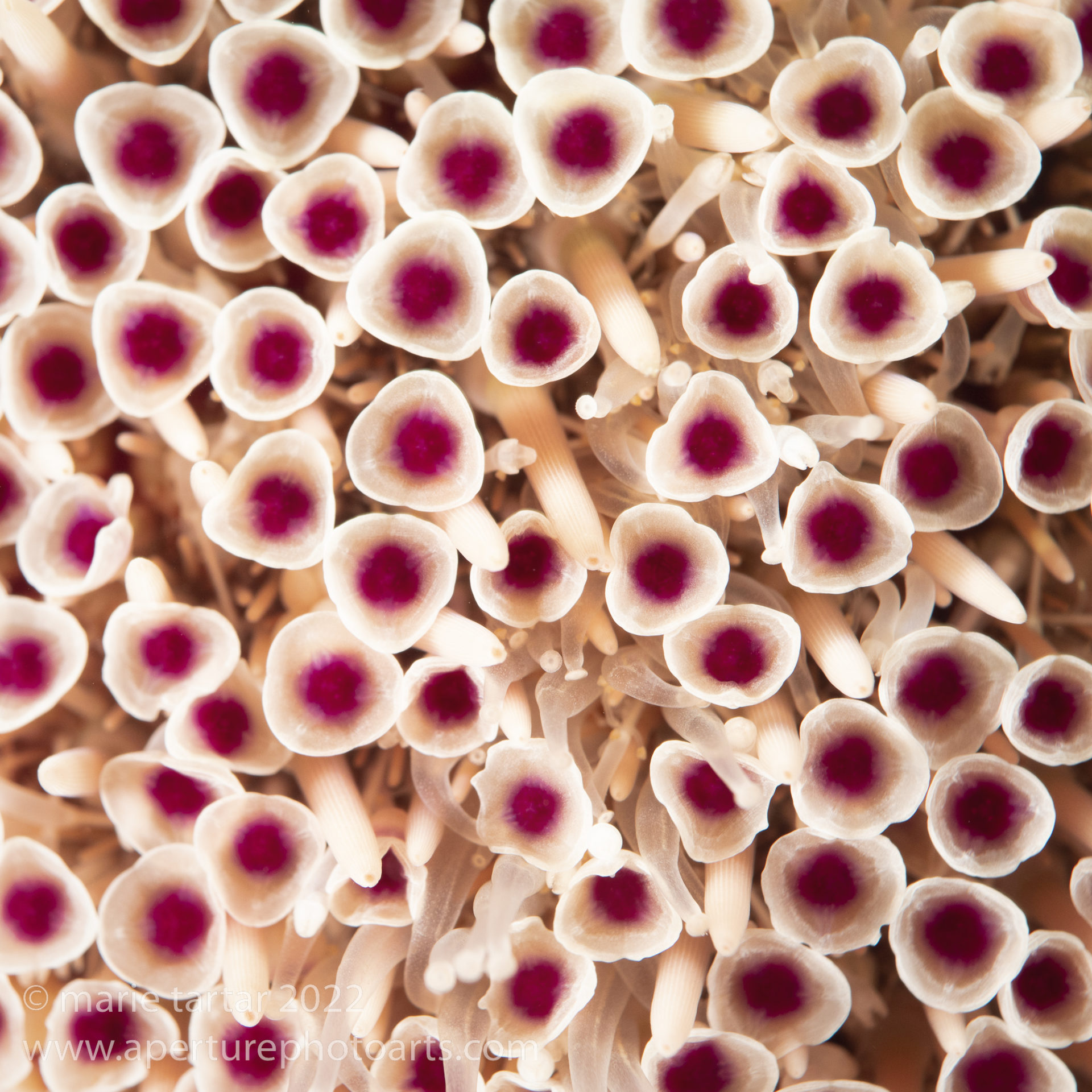
Flower urchin detail with the CMC, Isla Coronado, Sea of Cortez, Baja, Mexico. Usually these lovely urchins disguise themselves with not so lovely bits of shell.
I switched to shooting wide angle for the third dive at a site called Lighthouse (El Faro), a scrubby, not particularly attractive brown reef (61 min 33 ft).
Steve was missing in action when our group surfaced. He surfaced some distance away and was picked up by the other panga. He had his head in the reef shooting macro, while the rest of group moved on.
It was noticeably colder, so I finally broke out the new, emergency hooded vest I had Steve procure the day before departure when Lynn’s ACK!!! email came, warning of possible temperatures in the 60s as we progressed north.
Loreto was bathed in golden afternoon light as we strolled the streets, eventually finding ourselves at the historic mission, just as a wedding party spilled out front. A baby blue Volkswagon bug adorned with a bouquet of flowers on top was waiting in front for the wedding couple, who were feted with blowing bubbles by the guests who wearing their finest. The wedding videographer was busily recording the scene. As another photographer trained his lens on the couple, the groom looked over and laughing, said “quitale la tapa” (take the lens cap off!).

Big dress, small car: We happened on a wedding taking place at “the head and mother of the missions of upper and lower California”.
Afterwards, we eavesdropped on a choral group rehearsal inside the church and by the time Greg joined us, another celebratory group was assembling on the steps of the church. This one was centered on an elaborately made up and adorned adolescent girl, presumably a quinceanera.
We met up with Mike, Lynn, John and Rolf for dinner at a restaurant called Mediterraneo on the waterfront street, the Malecon. This restaurant was one of our friend Elena’s suggestions, seconded by divemaster Bob. We had a table on the second floor balcony, where a few other tables were occupied. We shared smoked brisket tostados as starters, with margaritas. Steve and I shared smoked chicken enchiladas and camarones ajillo with vegetables. Ruth and Yung were unimpressed with Orlando’s, which several ex-pats had recommended to them, saying the food was better on the boat.
Sunday October 16, 2022
Isla Ildefonso
On the dive deck this morning, there was a sure sign of colder water: Bob was donning a full wetsuit and hood. Up to this point, he hadn’t been seen wearing any neoprene, favoring head to toe orange clothing, from board shorts to a rash guard top.
Our first dive (64 min 61 ft ) was to twin pinnacles called Los Gemelos (The Twins). The water temperature was 80 degrees, which doesn’t sound too bad, but it clearly was much cooler than the mid-80s we’d enjoyed further south.
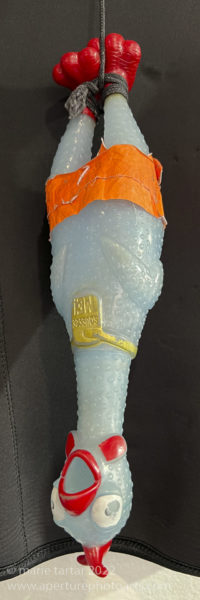
The mascot of the Rocio del Mar is this rubber chicken, “earned” and worn with pride whenever anyone forgot some critical piece of gear requiring a trip back to the ship. There were many contenders for this prize.
We lost Laura at the beginning of the dive. It turned out she forgot her weight belt and unable to descend, returned to the boat for it, earning the rubber chicken and diving with a later departing group.
The photographic highlight of my dive was an undecided green eel with a “should I stay or should I go now?” body posture.

Eels are constantly opening their mouths to move water over their gills. However, this view is most unusual, taken moments after the above, more conventional view and quite a surprise to me. Las Animas, Baja, Mexico.
Our second dive was named Asunahi’s Pinnacle (66 min 84 ft), but the highlight of the day was our 3rd dive, in the afternoon, to The Arch (63 min 98 ft), We went through the relatively deep arch itself mid-way through the dive and I was blown away by its beauty. I was so agog by this spectacular swim through festooned with fans and gorgonians that I took hardly any images. Outside of the arch, a turgid starfish was actively spawning, with thin streams of creamy gametes oozing out of the standing up starfish.
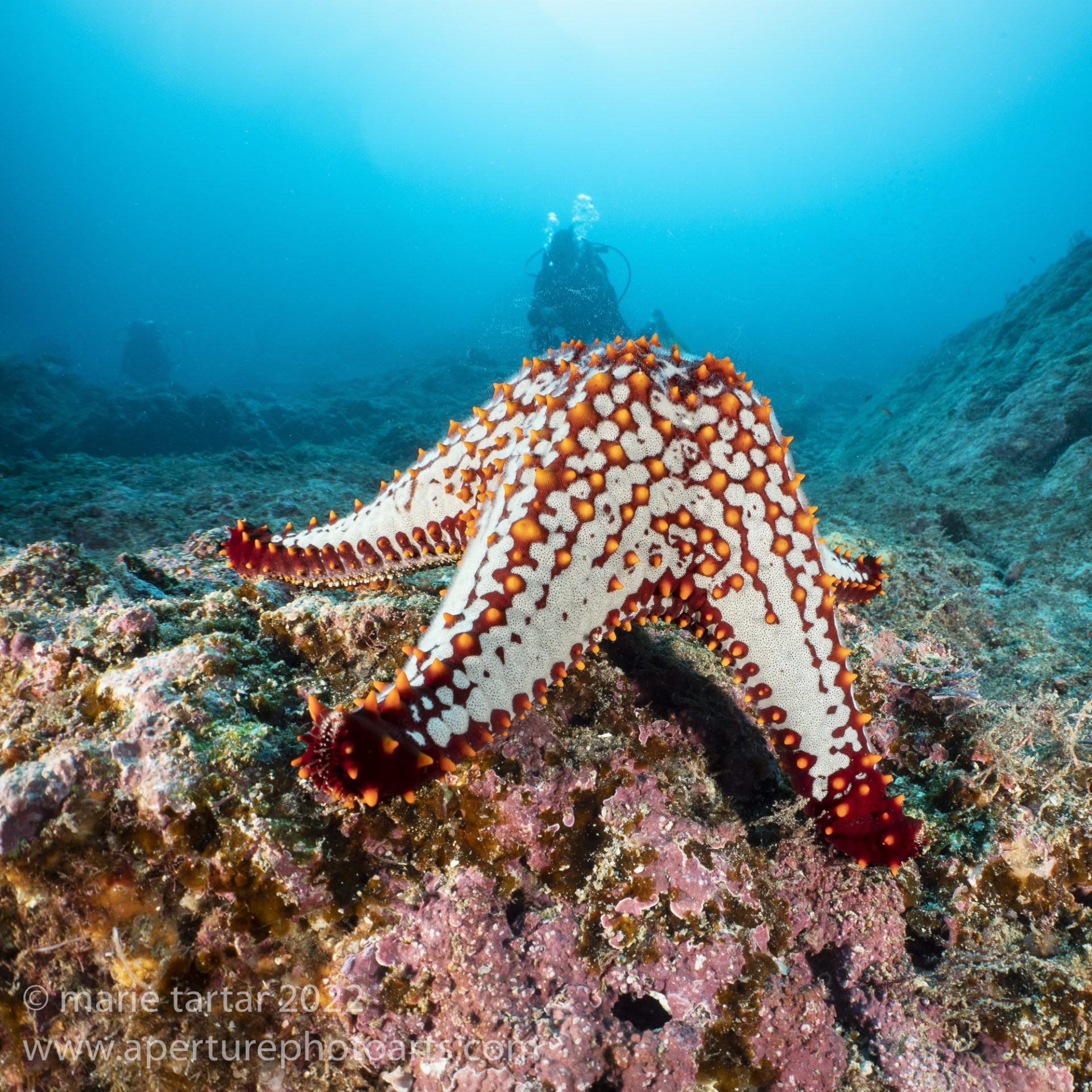
A starfish standing up, turgidly poised, can only mean one thing: it’s spawning! Look closely at the top of the starfish triangle, tiny white dots seen against the diver in the distance are gametes being oozed into the water column. (Panamic cushion star (Pentaceraster cumingi))
I was so taken with this site that afterwards I suggested to Bob and Lynn that it would be a shame not to dive there again. After some discussion, it was agreed. We’d stay another day, sacrificing a cold water dive further north.

A colorful pinto spiny lobster peers out of an equally colorful reef at isla Ildefonso in Baja, Mexico’s Sea of Cortez.
Joshua came through with enchiladas suizas (chicken enchiladas with a creamy green tomatillo sauce), a favorite of mine ever since our trip to Mexico City. Knowing the crew was reprovisioning in Loreto, I had asked him if this dish might be possible.
Monday, October 17, 2022
Isla Ildefonso

A trio of starfish anchor an Isla Ildefonso seascape, Baja, Sea of Cortez, Mexico. (Panamic cushion stars (Pentaceraster cumingi))
Our first dive (61 min 73 ft) of the morning had an unusual name, Boobu Rock. It consisted of rocky pinnacles. Dolphins appeared in the water while we were preparing to enter and kept Everardo company and appeared again on exiting. We tried swimming with them, but were rewarded with only a brief glimpse of the elusive and charismatic creatures.
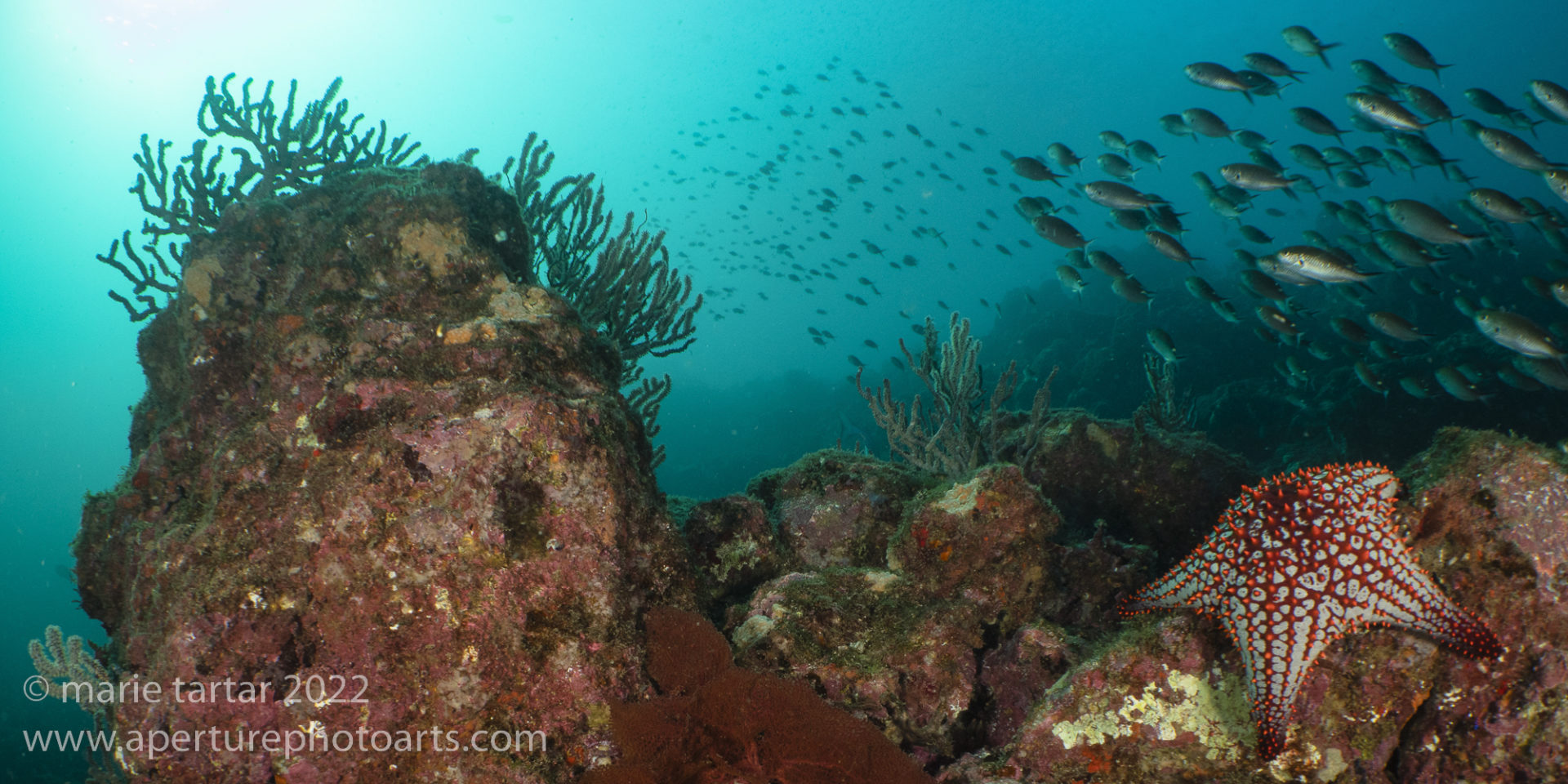
Reef scene, Isla Ildefonso, Baja, Mexico Sea of Cortez, with Panamic cushion star (Pentaceraster cumingi).
Our return to The Arch for a second dive (61 min 91 ft) was disappointing, with the visibility much reduced compared with the prior afternoon. Steve found an octopus in the shallows on our safety stop.
An afternoon dive to El Faro (The Lighthouse) (66 min 47 ft ) was notable for so many eels, free-swimming and tucked into crevices and canyons. Scissortail chromis streamed out of every nook and cranny. Many king angelfish in the same vicinity were reportedly eating chromis poop.
Tuesday October 18, 2022
Isla San Pedro Martir
We motored all night (14 hours), arriving at 6 am. To squeeze in 4 dives today, we are starting earlier, with the first dive at 7 am. Our usual routine has been a first dive at 8 am, followed by a hot breakfast, with the second morning dive usually at 11:30 am, with lunch at 1-1:30 pm. Afternoon dive times varied depending on how many were planned (1-2) and/or if a night dive or excursion was planned.
By now we have settled into the Rocio del Mar’s routine. Our tanks are refilled as soon we return to the boat. It’s up to us to analyze our Nitrox mix (shooting for 32%), record it, hook up our regulators to our tanks, check the pressure and record that. Weight pockets, which were handed up to the panga driver to lighten the load of hoisting our tanks out of the water, must be replaced. To minimize the congestion of the dive deck, the three groups undergo successive briefings, with the bell being sounded and the first group summoned with a bellowed “Group AAAAAAAA” 15 minutes before the scheduled dive departure. Meanwhile, the next group would be donning scuba socks, skins, wetsuits, booties and hoods upstairs to be ready for their bellowed summons.
This morning, Bob sent a dive watch into the depths, suspended on a rope, to give us a temperature preview: 76 degrees F on the surface.
Dive 1: El Morro 76 degrees 60 min 82 ft
I felt my stick slide off my wrist on the backroll into the water. I peered down, hoping to see it just a few feet below me and was shocked that it was so turbid I basically could not see anything.
I had resigned myself to losing it, so was pleasantly surprised to see it again back on the panga- Marco had found it. The water was shockingly dark, green, cold and filled with particulates. The visibility was so limited, it was hard to see the rest of the group, so we stuck together unusually close. We were all amazed that we did not lose each other underwater.
Having dove so recently in the cold, dark, green waters of British Columbia proved useful dealing with these conditions. A forest of bushy yellow black coral awaited down below.
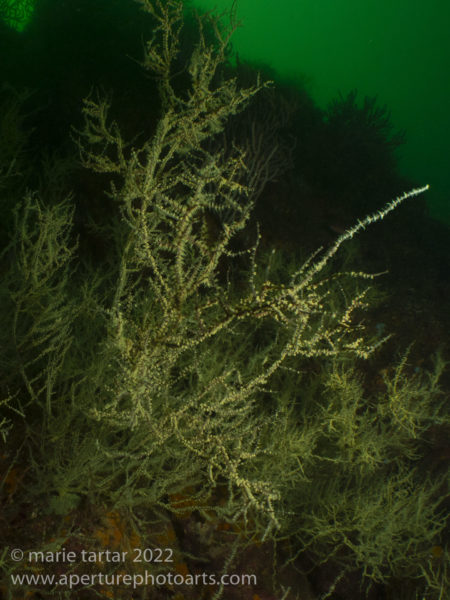
Another world at Isla San Pedro Martir: dark, murky, green water, with a dense forest of black coral trees.
Dive 2 Corralito 65 min 59 ft
Laura stayed back to do some work. A pair of seahorses had been sighted on this site on earlier trips. The pair had shifted positions slightly but were nearby. Greg and I tried to wait out the sand Yung scattered over their heads departing the site. Marco went to bring Steve to shoot them. Meanwhile, sea lions zipped in and out of our sand arena.

Dark green cold water at San Pedro Martir means time to switch to macro: a scorpionfish on a matching algea substrate in Baja’s Sea of Cortez, Mexico.
For our 3rd dive (59 min, 80 ft) to El Arroyo (The Wash), I changed to macro. We had the same terrible visibility, but saw many nudibranchs (Tambja abdere) and speckled flatworms ( Pseudobiceros bajae). Sea lions were darting about.

This is the first trip I really started to use my CMC attachment to my macro lens, which definitely was an asset with subjects like this beautiful nudibranch, Tambja abdere.
There were only 4 takers for the dive night (56 min 60 ft), a return to Corralito. Steve, Greg, Mary and I were guided by Marco. We revisited the sea horses and Steve found an octopus. Surprisingly, the visibility seemed much better than it had been during the day.
Wednesday October 19, 2022
Bahia de Los Angeles
Today is our last day on board the Rocio del Mar and to squeeze as much as possible into it, we started early, with a 7 am dive at a site called Punta Don Juan (62 min, 60 ft).
The briefing indicated there were two neighboring giant jawfishes living at a depth of about 55 feet.
Our group found a small one and later joined up with Bob’s group circling the described neighboring and much bigger giant jawfishes, which lunged from their sand burrows to scavenge the shrimp offerings.
Bob crowed “I am the frogfish king” on the return of his group. He had mentioned during the briefing that they had been found inside black coral bushes. Despite scouring every black coral bush in sight, we didn’t find any, but he found two!
At 9:30 am, 3 pangas from Bahia de Los Angeles picked us up for a whale shark snorkel. The water’s surface was glassy smooth. It took a while to locate a whale shark but when we did, it stuck around until we had to depart. We alternated, 4 swimmers at a time, churning madly trying to keep up with the cruising baby behemoth. It was tiring but exhilarating fun. In our group, Ruth didn’t enter the water and Laura skipped many of her turns. This was her first time to see a whale shark.

The visibility wasn’t the best in Bahia de Los Angeles but it was still a blast swimming with this young whale shark.
Joshua surprised me with a special lunch. Instead of the cheese-filled chile rellenos on the menu, I was presented with a version of one of my favorite Mexican dishes, chiles en nogada, which I have loved ever since first tasting it in Tepoztlan in 2013. I had asked him earlier in the week if he knew how to make it and he said he would make it for me. I don’t know how he pulled it off because our conversation was after the crew re-provisioned in Loreto. It is a delicious and savory, as well as colorful, dish, with green chiles filled with a savory spiced meat and dried fruit mixture, topped with a creamy white sauce (traditionally made with nogadas, a type of walnut) and sprinkled with pomegranate seeds. The colors reference those of the Mexican flag.
All fun must come to an end. It had been a great trip, with a wonderful variety of creatures, great and small. The afternoon saw us arranging dive gear for drying, packing, and breaking down cameras. The crossing made me queasy enough while disassembling the camera to put on a second half Scopolamine patch (thank you, Lynn!) and lie down. We did drum up participation for a group slide show before dinner, always great fun to see alternate visions.
While I was packing my gear, I noticed an addition to my white plastic slate, which dangles from a D-ring on my BCD, which made me laugh out loud. I’ve never actually written a message on it or used it as a slate, but like having it available to white balance, in case I want to shoot video and don’t have any sand readily available. Someone (I suspect Greg!) had added an urgent message: Ask me about convertible mortgages! I have to hope this was a recent embellishment and that I hadn’t been swimming around the entire trip with this message dangling from my rig!
-Marie

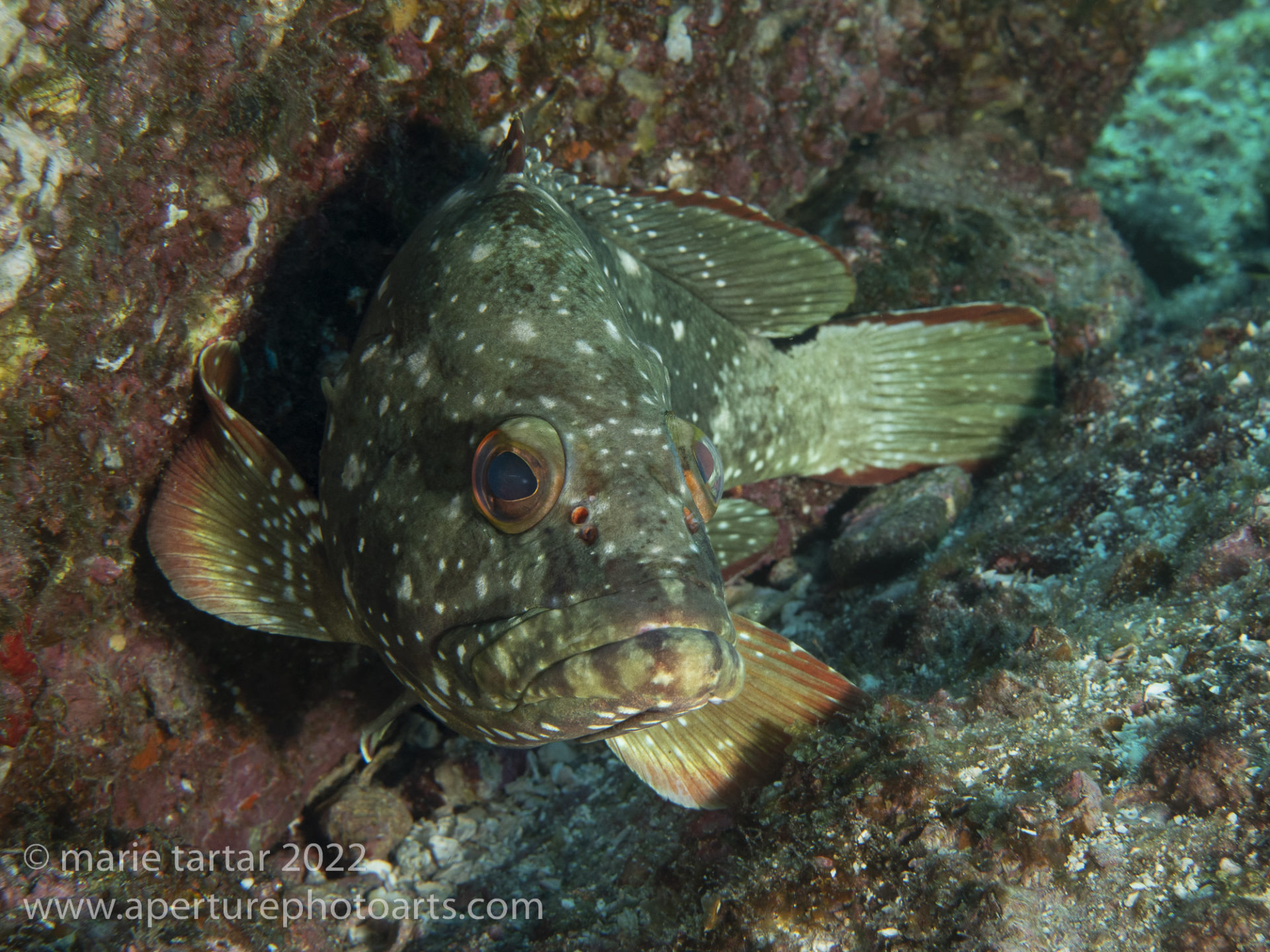
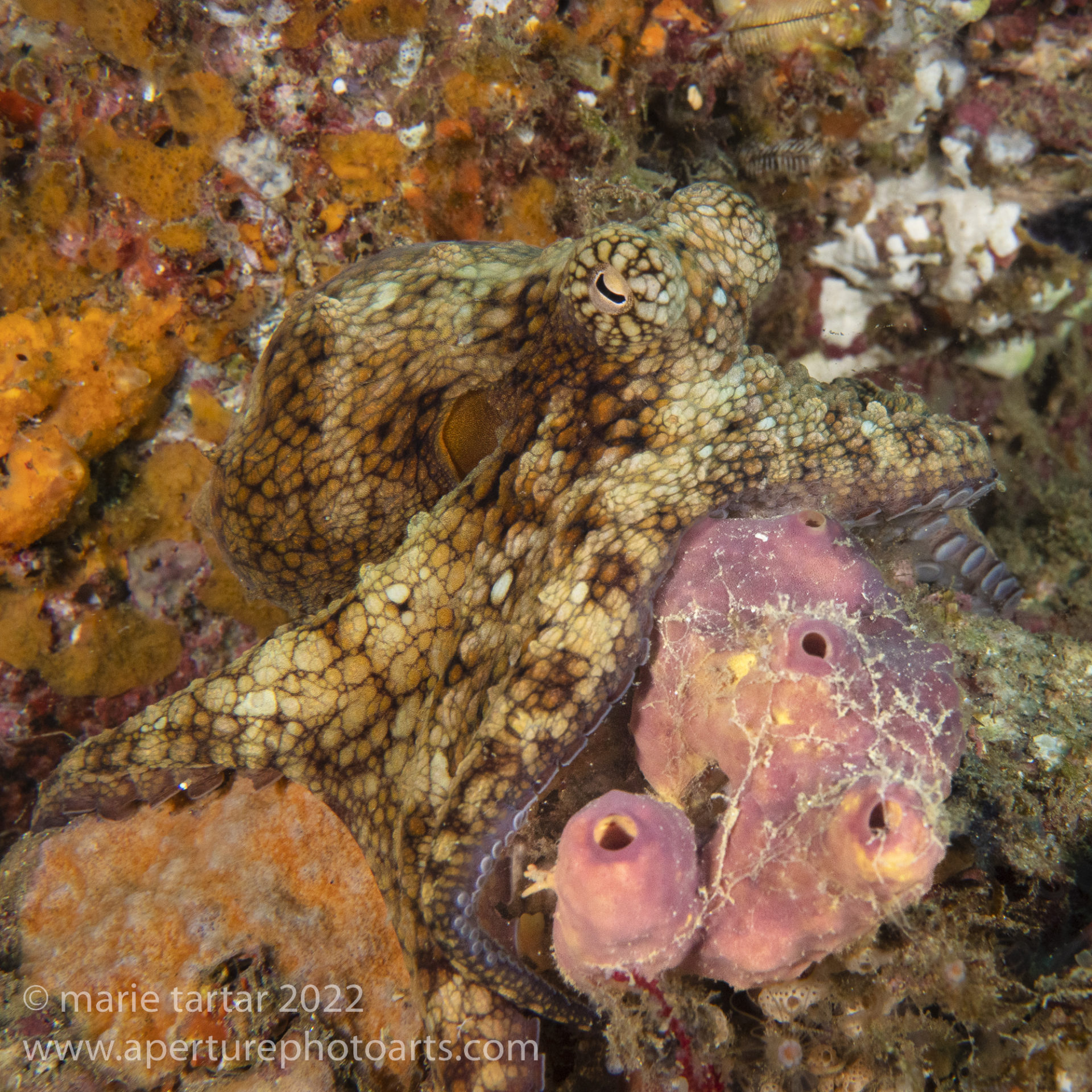
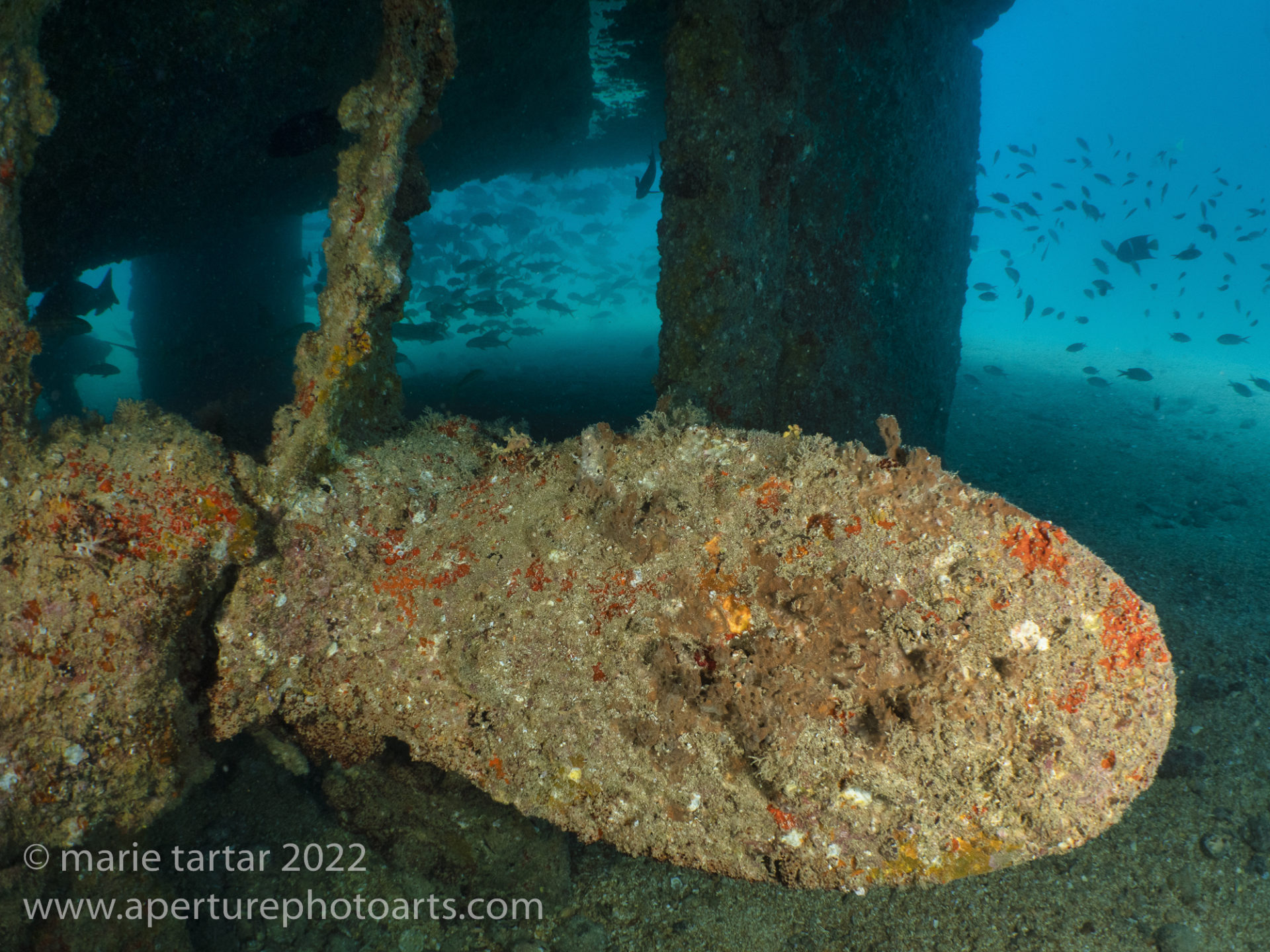


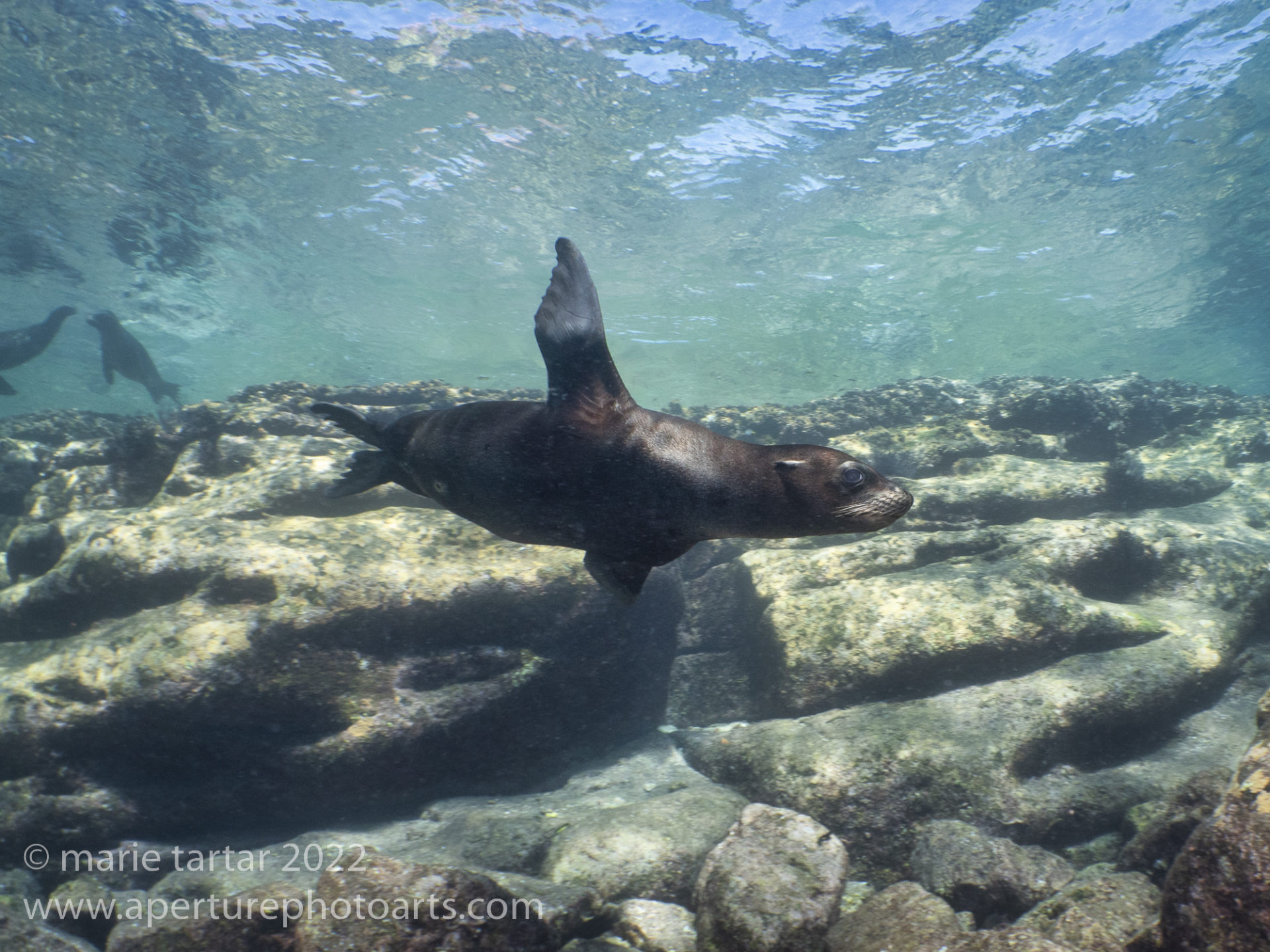


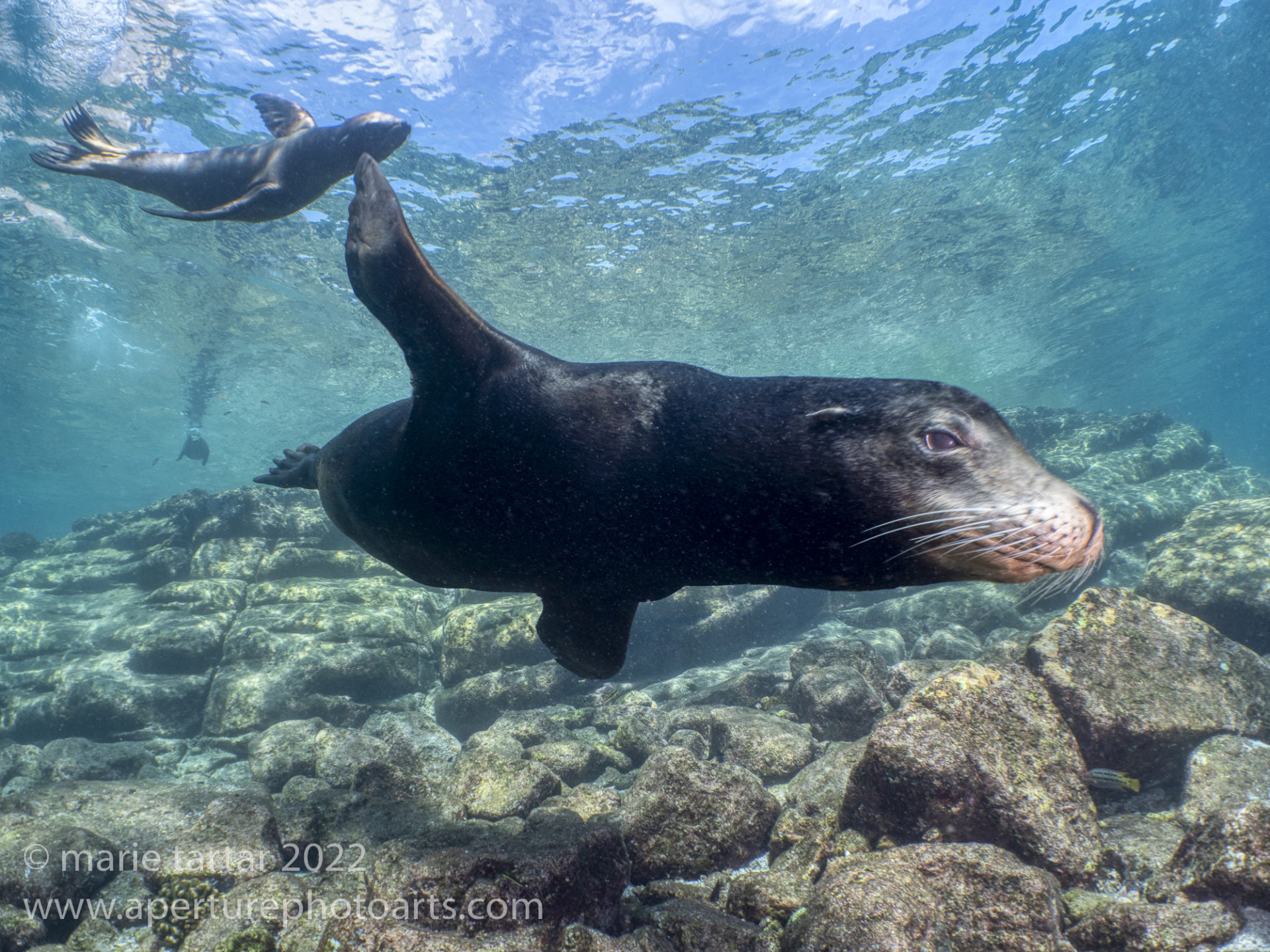



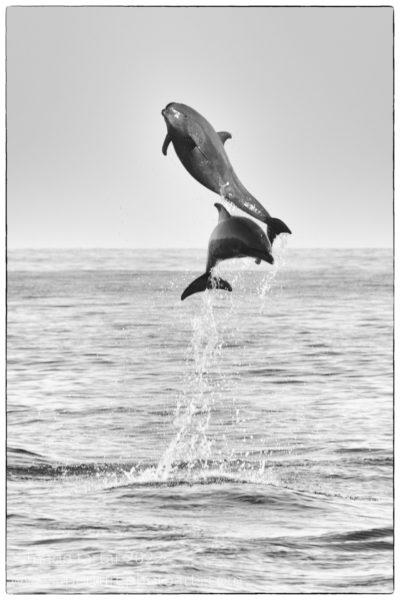
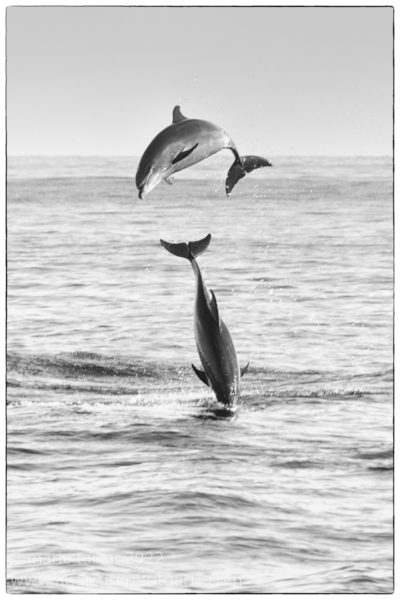



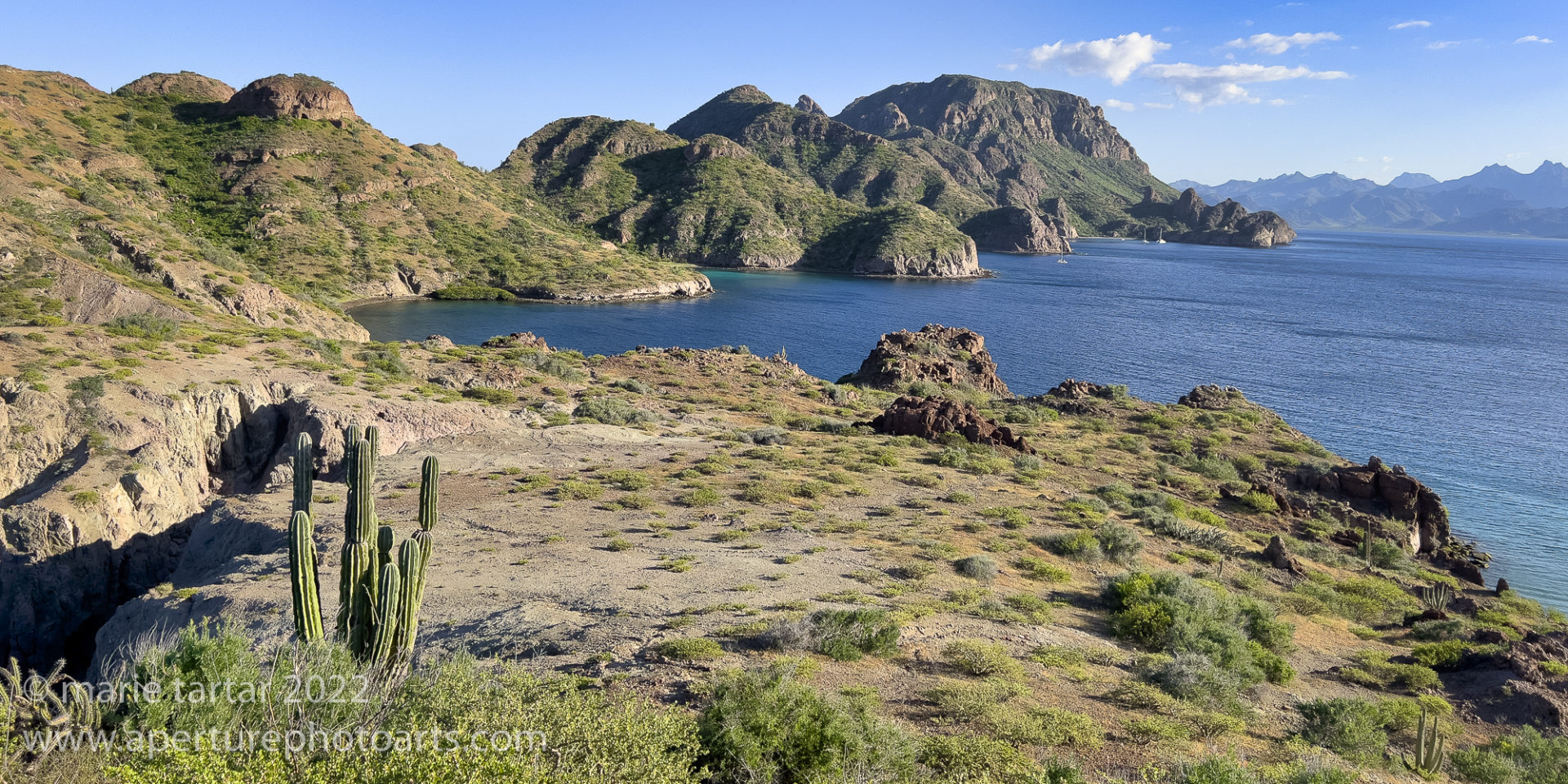



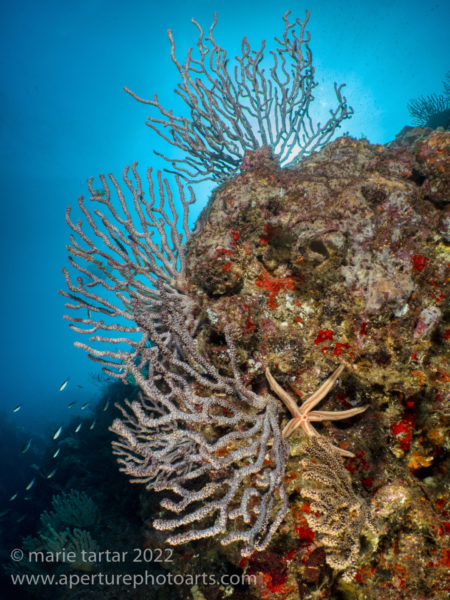




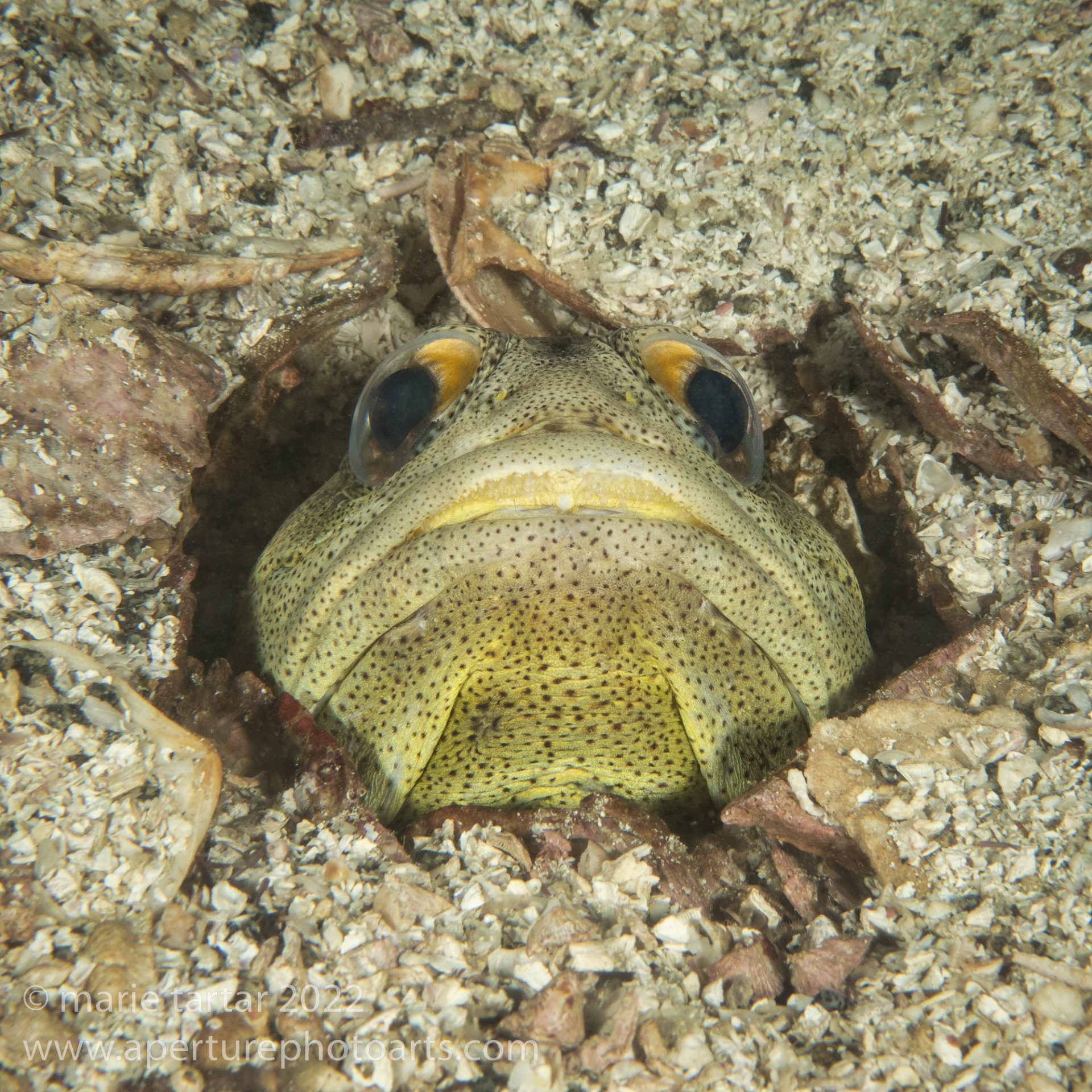
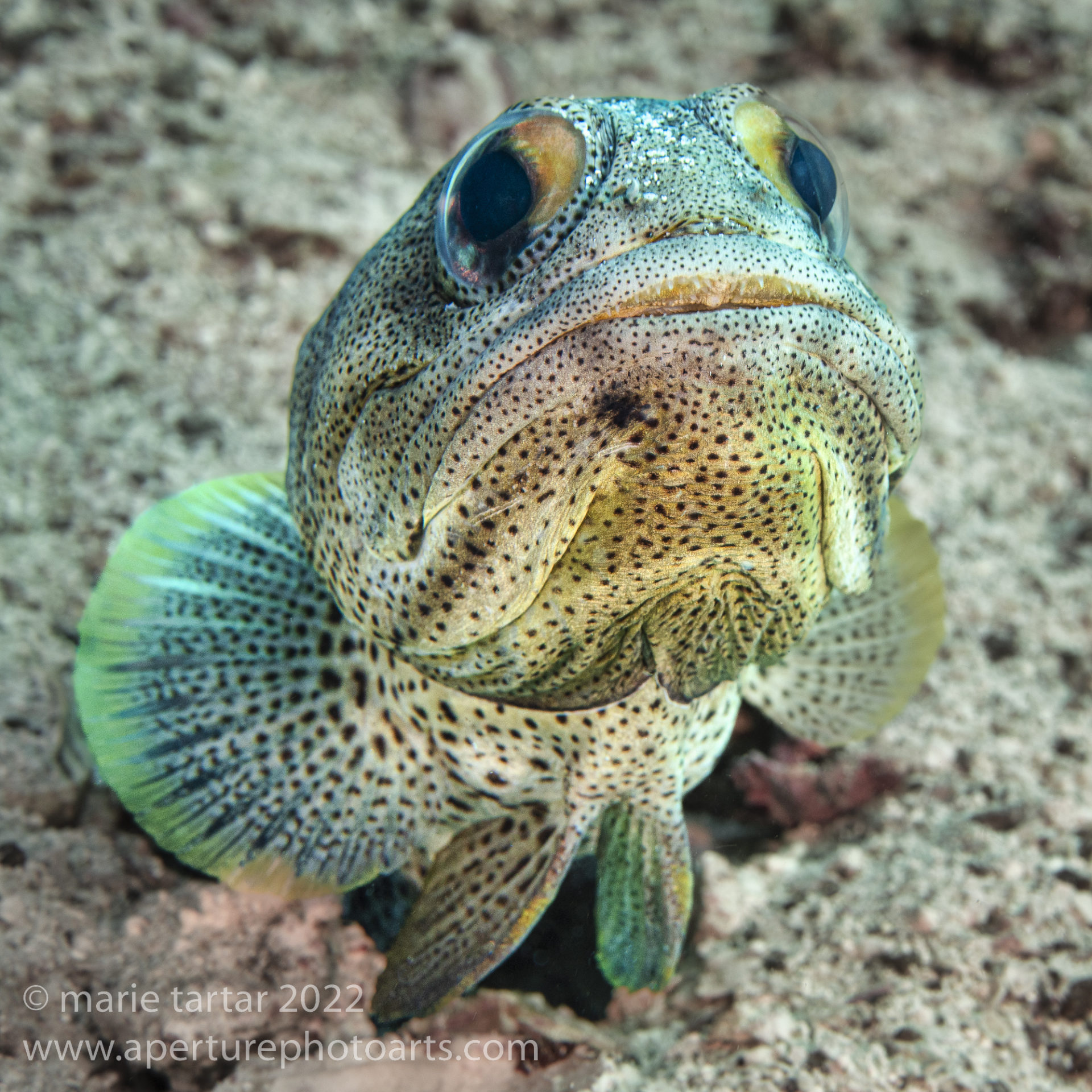
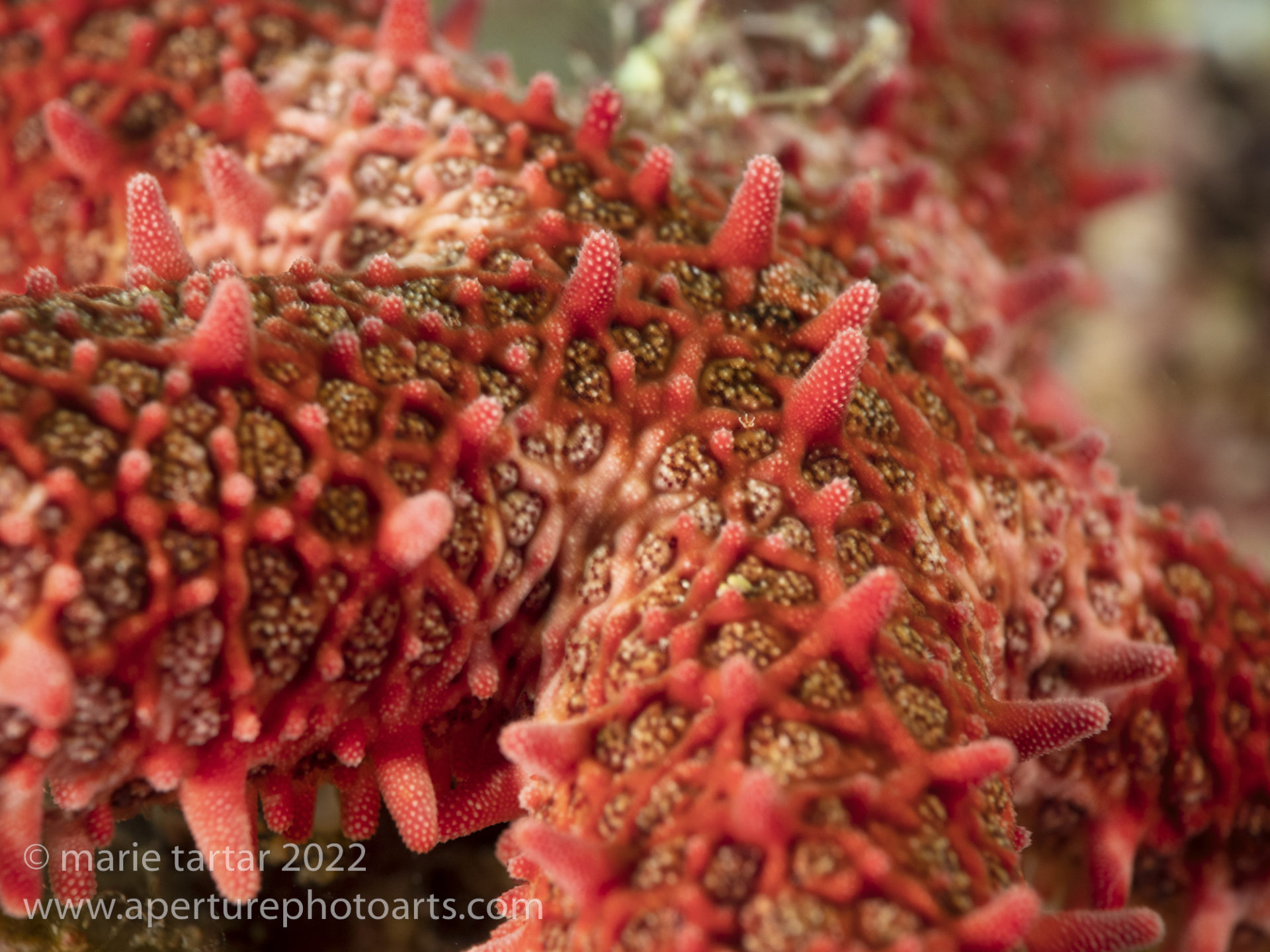
Excellent blog! Thank you for the beautiful photos and descriptions. Glad someone took good notes. It was a fun trip. Maybe I’ll see you on another diving adventure in the future.
Dave
Hi Dave, I look forward to that!
-Marie